 |
 |
 |
 |
 |
 |
 |
 |
 |
 |
|
KICP News
|
KICP in the News, 2015
Neutrino astronomy: Balloon with a view The Economist, January 20, 2015 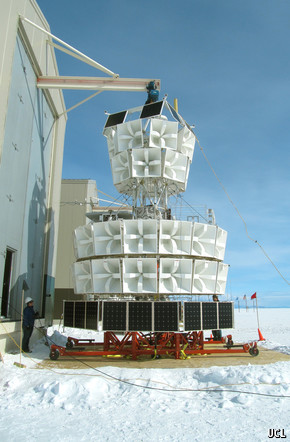 An experiment in Antarctica may solve the mystery of cosmic rays MEET ANITA. Strictly, ANITA III--for she is the third iteration of the Antarctic Impulsive Transient Antenna. Her job, when she is launched sometime in the next few days, will be to float, suspended from a giant balloon, over Antarctica's ice, in order to record radio waves which that ice is giving off. These radio waves are generated by neutrinos passing through the ice, making Antarctica the biggest neutrino-detection laboratory in the world. The particular neutrinos that ANITA seeks are of extremely high energy. Where they come from, no one knows--nor, strictly speaking, is it actually known that they exist, for ANITAs I and II, which were smaller devices, failed to find them. But theory says they should be there, generated in whatever giant explosions also create cosmic rays. Cosmic rays are high-velocity protons, sprinkled with a smattering of heavier atomic nuclei, that fly through space until they hit something such as Earth's atmosphere, when they disintegrate into a shower of other particles. They have been known for a century, but their origin remains mysterious because, being electrically charged, their paths are bent by the galaxy's magnetic field. That means the directions they come from do not point to whatever created them. Neutrinos, however, are electrically neutral, as their name suggests. Their paths should thus point back towards their origins. Neutrinos do not interact much with other sorts of matter, but when one of ultra-high energy does so, the result is a shower of particles travelling at speeds which exceed that of light in ice. An object travelling faster than light's speed in the medium through which it is passing will generate electromagnetic waves. These are known, after their discoverer, as Cherenkov radiation. And it is pulses of radio-frequency Cherenkov radiation, the electromagnetic equivalent of a sonic boom, which ANITA is looking for. Once airborne under her balloon--an object made of cling-film-like plastic that, when fully inflated, will be a fifth of the size of a football stadium--ANITA will take advantage of the polar vortex, a wind in constant revolution around the pole. She will fly at an altitude of 35-40km, which will mean her antennae can see 1.5m km2 of ice. Ultra-high-energy neutrinos travelling through the ice are thought to interact with it and produce Cherenkov radiation about once per century per km^2, so an area of this size would be expected to yield about 40 bursts a day. ANITA will complete several laps of the continent, each lasting about 15 days. Then the balloon will be cut loose, and she will deploy a parachute and be guided back to the surface for re-use. Astrophysicists are not the only people rubbing their mittens together in expectation of the results of this experiment. The neutrinos ANITA is looking for are far more energetic than anything produced by the Large Hadron Collider, the world's most powerful particle accelerator. That means they may obey hitherto unperceived extensions of the laws of physics. One possibility is that, among the Cherenkov-radiation-generating particles produced when a neutrino collides with the ice, there may be an occasional miniature black hole. That would be particularly exciting, because such black holes might themselves disintegrate in a characteristic puff of radiation named after another physicist, Stephen Hawking. If Hawking radiation exists, it means black holes are not truly black--a discovery which would almost certainly win Dr Hawking a Nobel prize. Though it is not designed to search for Hawking radiation, ANITA would probably see it if it were there. And, since Hawking radiation is created, quite literally, out of nothing (the particles it is made from emerge from the vacuum of space and then steal the energy needed to become real from the black hole itself), that would assist understanding of a very strange piece of physics indeed. Read more >> Related Links: KICP Members: Keith Bechtol; Abigail G. Vieregg Scientific projects: Antarctic Impulsive Transient Antenna (ANITA) Mystery of the Universe's Gamma-Ray Glow Solved Space.com, February 5, 2015 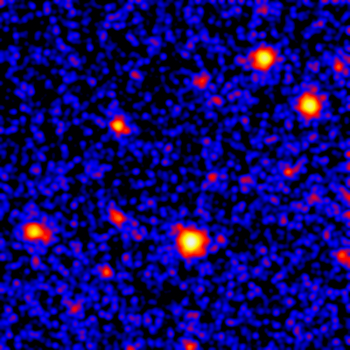 The steady glow of high-energy gamma-ray light that spreads across the cosmos has puzzled astronomers for decades. One team of researchers thinks it has the best explanation yet for the source of this strange emission. After observing the universe with NASA's Fermi Gamma-ray Space Telescope for six years, scientists with the mission say the majority of the gamma-ray glow they have seen can be explained by objects already known to science. If there are any as-yet unknown sources out there, their contribution to the glow would be very small, scientists say. "We have a very plausible story. We're not 100 percent confident that this is the final answer, but it really constrains what other exotic possibilities could be out there," said Keith Bechtol, a postdoctoral researcher at the University of Chicago and a member of the Fermi collaboration who worked on the analysis. Read more >> Related Links: KICP Members: Keith Bechtol Scientific projects: Fermi Gamma-ray Space Telescope (Fermi) One Hundred Years of General Relativity Science Friday, March 6, 2015 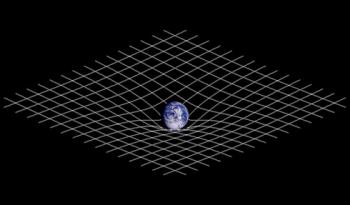 Image by Johnstone/CC BY-SA 3.0 Albert Einstein published his theory of general relativity 100 years ago. The theory has shaped the idea of black holes, pulsars, and modern cosmology. Science historian David Kaiser guides us through the history of Einstein's insight, and physicists Michael Turner and Alex Filippenko discuss where the theory might take us in the future. Guests
Read more >> Related Links: KICP Members: Michael S. Turner Scientists find rare dwarf satellite galaxy candidates in Dark Energy Survey data Fermilab, March 11, 2015 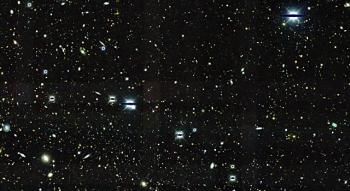 Image credit: Image: Fermilab/Dark Energy Survey. Scientists on two continents have independently discovered a set of celestial objects that seem to belong to the rare category of dwarf satellite galaxies orbiting our home galaxy, the Milky Way. Dwarf galaxies are the smallest known galaxies, and they could hold the key to understanding dark matter and the process by which larger galaxies form. A team of researchers with the Dark Energy Survey, headquartered at the U.S. Department of Energy's Fermi National Accelerator Laboratory, and an independent group from the University of Cambridge jointly announced their findings today. Both teams used data taken during the first year of the Dark Energy Survey, all of which is publicly available, to carry out their analysis. "The large dark matter content of Milky Way satellite galaxies makes this a significant result for both astronomy and physics," said Alex Drlica-Wagner of Fermilab, one of the leaders of the Dark Energy Survey analysis. Satellite galaxies are small celestial objects that orbit larger galaxies, such as our own Milky Way. Dwarf galaxies can be found with fewer than 100 stars and are remarkably faint and difficult to spot. (By contrast, the Milky Way, an average-sized galaxy, contains billions of stars.) These newly discovered objects are a billion times dimmer than the Milky Way and a million times less massive. The closest of them is about 100,000 light-years away. "The discovery of so many satellites in such a small area of the sky was completely unexpected," said Cambridge's Institute of Astronomy's Sergey Koposov, the Cambridge study's lead author. "I could not believe my eyes." Scientists have previously found more than two dozen of these satellite galaxies around our Milky Way. About half of them were discovered in 2005 and 2006 by the Sloan Digital Sky Survey, the precursor to the Dark Energy Survey. After that initial explosion of discoveries, the rate fell to a trickle and dropped off entirely over the past five years. The Dark Energy Survey is looking at a new portion of the southern hemisphere, covering a different area of sky than the Sloan Digital Sky Survey. The galaxies announced today were discovered in a search of only the first of the planned five years of Dark Energy Survey data, covering roughly one-third of the portion of sky that DES will study. Scientists expect that the full Dark Energy Survey will find up to 30 of these satellite galaxies within its area of study. Atlas image obtained as part of the Two Micron All Sky Survey (2MASS), a joint project of the University of Massachusetts and the Infrared Processing and Analysis Center/California Institute of Technology, funded by the National Aeronautics and Space Administration and the National Science Foundation. While more analysis is required to confirm any of the observed celestial objects as satellite galaxies, researchers note their size, low surface brightness and significant distance from the center of the Milky Way as evidence that they are excellent candidates. Further tests are ongoing, and data collected during the second year of the Dark Energy Survey could yield more of these potential dwarf galaxies to study. Newly discovered galaxies would also present scientists with more opportunities to search for signatures of dark matter. Dwarf satellite galaxies are dark matter-dominated, meaning they have much more mass in unseen matter than in stars. The nature of this dark matter remains unknown but might consist of particles that annihilate each other and release gamma rays. Because dwarf galaxies do not host other gamma ray sources, they make ideal laboratories to search for signs of dark matter annihilation. Scientists are confident that further study of these objects will lead to even more sensitive searches for dark matter. In a separate result also announced today, the Large Area Telescope Collaboration for NASA's Fermi Gamma-Ray Telescope mission reported that they did not see any significant excess of gamma ray emission associated with the new Dark Energy Survey objects. This result demonstrates that new discoveries from optical telescopes can be quickly translated into tests of fundamental physics. "We did not detect significant emission with the LAT, but the dwarf galaxies that DES has and will discover are extremely important targets for the dark matter search," said Peter Michelson, spokesperson for the LAT collaboration. "If not leading to an identification of particle dark matter, they will certainly be useful to constrain its properties." The Dark Energy Survey is a five-year effort to photograph a large portion of the southern sky in unprecedented detail. Its primary instrument is the Dark Energy Camera, which - at 570 megapixels - is the most powerful digital camera in the world, able to see galaxies up to 8 billion light-years from Earth. Built and tested at Fermilab, the camera is now mounted on the 4-meter Victor M. Blanco telescope at the Cerro Tololo Inter-American Observatory in the Andes Mountains in Chile. The survey's five-year mission is to discover clues about the nature of dark energy, the mysterious force that makes up about 70 percent of all matter and energy in the universe. Scientists believe that dark energy may be the key to understanding why the expansion of the universe is accelerating. "The Dark Energy Camera is a perfect instrument for discovering small satellite galaxies," said Keith Bechtol of the Kavli Institute for Cosmological Physics at the University of Chicago, who helped lead the Dark Energy Survey analysis. "It has a very large field of view to quickly map the sky and great sensitivity, enabling us to look at very faint stars. These results show just how powerful the camera is and how significant the data it collects will be for many years to come." The Dark Energy Survey is a collaboration of more than 300 scientists from 25 institutions in six countries. Read more >> Related Links: KICP Members: Keith Bechtol; Alex Drlica-Wagner; Joshua A. Frieman Scientific projects: Dark Energy Survey (DES) John E. Carlstrom, Thomas M. Crawford and Lloyd Knox, "Particle physics and the cosmic microwave background" Physics Today, March 13, 2015  Temperature and polarization variations across the microwave sky include the fingerprints of quantum fluctuations in the early universe. They may soon reveal physics at unprecedented energy scales. The detection of the CMB and the consensus that the universe had a hot and dense early phase led to a fertile relationship between cosmology and particle physics. The hot early universe was a natural particle accelerator that could reach energies well beyond what laboratories on Earth will attain in the foreseeable future. Precise measurements of both the spectrum of the CMB and its tiny variations in brightness from one point to another on the sky reflect the influences of high-energy processes in the early cosmos. For instance, the gravitational effects of neutrinos have been detected at high significance; such measurements imply that the sum of the neutrino masses is no more than a few tenths of an eV. The CMB data also show the influence of helium produced in the early universe and thus constrain the primordial helium fraction. Moreover, the data are nearly impossible to fit without dark energy and dark matter - two ingredients missing from the standard model of particle physics. Read more >> Related Links: KICP Members: John E. Carlstrom; Thomas M. Crawford Scientific projects: South Pole Telescope (SPT) Understanding the Dark Side of Physics Science Friday, March 27, 2015 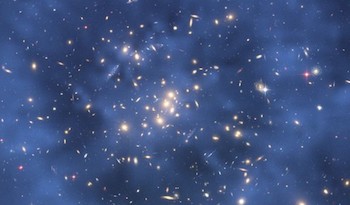 Neutrons, protons, and electrons - these are the basic building blocks of matter. But this kind of matter is only a tiny fraction of the entire universe. The rest, about 95 percent, in fact, is divided between dark matter and dark energy. Understanding what makes up dark matter and dark energy could help answer some of the biggest questions in physics. Physicists Jodi Cooley, Dan Hooper, and Nobel Prize winner Steven Weinberg join Ira Flatow to discuss what we do and don't know about this "darker" side of physics, and what we hope to learn. Guests Steven Weinberg Author, "To Explain the World: The Discovery of Modern Science" (HarperCollins, 2015) Nobel Prize Winner, 1979, Physics University of Texas at Austin Austin, Texas Dan Hooper Staff Scientist, Fermilab KICP Associate Professor, Astronomy and Astrophysics University of Chicago Chicago, Illinois Jodi Cooley Associate Professor, Physics Southern Methodist University Dallas, Texas Read more >> Horizon 2015 : Dancing in the Dark - The End of Physics? BBC, March 30, 2015 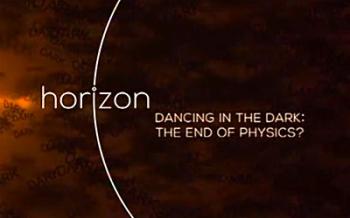 Scientists genuinely don't know what most of our universe is made of. The atoms we're made from only make up four per cent. The rest is dark matter and dark energy (for 'dark', read 'don't know'). The Large Hadron Collider at CERN has been upgraded. When it's switched on in March 2015, its collisions will have twice the energy they did before. The hope is that scientists will discover the identity of dark matter in the debris. The stakes are high - because if dark matter fails to show itself, it might mean that physics itself needs a rethink. Read more >> Related Links: KICP Members: Juan I. Collar; Daniel Hooper Mapping dark matter may help solve a cosmic mystery PBS, April 15, 2015 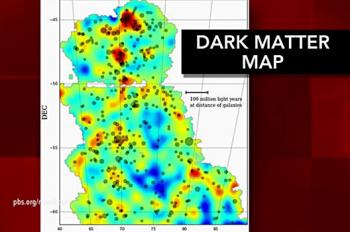 Scientists have announced the creation of the largest map yet of the invisible material that helps make up the universe, what's known as dark matter. Jeffrey Brown explores some of the very cosmic questions around this story. JEFFREY BROWN: That's worth saying again: We can't see it, but we can apparently map it. What's called dark matter is, in fact, everywhere, and it's believed to play a crucial role in forming and holding together galaxies with its gravitational pull. In findings announced Monday, researchers used a dark energy camera and a large telescope in Northern Chile to create this color-coded map, showing a small piece of the visible sky. Orange and red areas represent denser concentrations of dark matter. Blue areas are less dense. Read more >> Related Links: KICP Members: Joshua A. Frieman Scientific projects: Dark Energy Survey (DES) Scientists Release Largest Map Yet Of Dark Matter In The Cosmos NPR, April 15, 2015 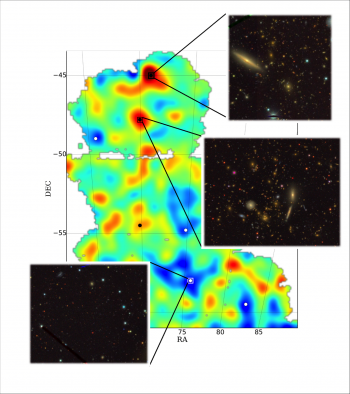 Researchers from the Dark Energy Survey used data captured by the Dark Energy Camera, a 570-megapixel imaging device they say is one of the world's most powerful digital cameras, to put together the largest contiguous map of dark matter created. They presented their findings Monday at a meeting of the American Physical Society in Baltimore. The scientists say the map covers only about 3 percent of the area of sky. They hope it will improve understanding of the role dark matter plays in the creation of galaxies - and to investigate dark energy. "We measured the barely perceptible distortions in the shapes of about 2 million galaxies to construct these new maps," Vinu Vikram of Argonne National Laboratory, one of the lead scientists on the study, said in a statement Monday. "They are a testament not only to the sensitivity of the Dark Energy Camera, but also to the rigorous work by our lensing team to understand its sensitivity so well that we can get exacting results from it." The Fermi National Accelerator Laboratory built and tested the camera, which is mounted on the 4-meter Victor M. Blanco telescope at the Cerro Tololo Inter-American Observatory in Chile. The National Center for Supercomputing Applications at the University of Illinois in Urbana-Champaign processed the data that went into the map. Here's more from the statement: "As scientists expand their search, they will be able to better test current cosmological theories by comparing the amounts of dark and visible matter. "Those theories suggest that, since there is much more dark matter in the universe than visible matter, galaxies will form where large concentrations of dark matter (and hence stronger gravity) are present. So far, the DES analysis backs this up: The maps show large filaments of matter along which visible galaxies and galaxy clusters lie and cosmic voids where very few galaxies reside. Follow-up studies of some of the enormous filaments and voids, and the enormous volume of data, collected throughout the survey will reveal more about this interplay of mass and light." "Our analysis so far is in line with what the current picture of the universe predicts," said Chihway Chang, another of the lead scientists who is with ETH Zurich. "Zooming into the maps, we have measured how dark matter envelops galaxies of different types and how together they evolve over cosmic time. We are eager to use the new data coming in to make much stricter tests of theoretical models." The Dark Energy Survey is on the second year of a five-year study. Read more >> Related Links: KICP Members: Joshua A. Frieman; Vinu Vikram Scientific projects: Dark Energy Survey (DES) Virtual Telescope Expands to See Black Holes University of Arizona News, April 21, 2015 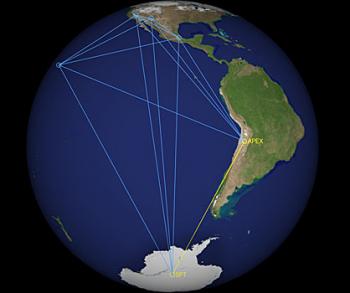 Astronomers building an Earth-size virtual telescope capable of photographing the event horizon of the black hole at the center of our Milky Way have extended their instrument to the bottom of the Earth - the South Pole - thanks to recent efforts by a team led by Dan Marrone of the University of Arizona. Marrone, an assistant professor in the UA's Department of Astronomy and Steward Observatory, and several colleagues flew to the National Science Foundation's Amundsen-Scott South Pole Station in December to bring the South Pole Telescope, or SPT, into the largest virtual telescope ever built - the Event Horizon Telescope, or EHT. By combining telescopes across the Earth, the EHT will take the first detailed pictures of black holes. The EHT is an array of radio telescopes connected using a technique known as Very Long Baseline Interferometry, or VLBI. Larger telescopes can make sharper observations, and interferometry allows multiple telescopes to act like a single telescope as large as the separation - or "baseline" - between them. "Now that we've done VLBI with the SPT, the Event Horizon Telescope really does span the whole Earth, from the Submillimeter Telescope on Mount Graham in Arizona, to California, Hawaii, Chile, Mexico, Spain and the South Pole," Marrone said. "The baselines to SPT give us two to three times more resolution than our past arrays, which is absolutely crucial to the goals of the EHT. To verify the existence of an event horizon, the 'edge' of a black hole, and more generally to test Einstein's theory of general relativity, we need a very detailed picture of a black hole. With the full EHT, we should be able to do this." The prime EHT target is the Milky Way's black hole, known as Sagittarius A* (pronounced "A-star"). Even though it is 4 million times more massive than the sun, it is tiny to the eyes of astronomers. Because it is smaller than Mercury's orbit around the sun, yet almost 26,000 light-years away, studying its event horizon in detail is equivalent to standing in California and reading the date on a penny in New York. With its unprecedented resolution, more than 1,000 times better than the Hubble Space Telescope, the EHT will see swirling gas on its final plunge over the event horizon, never to regain contact with the rest of the universe. If the theory of general relativity is correct, the black hole itself will be invisible because not even light can escape its immense gravity. First postulated by Albert Einstein's general theory of relativity, the existence of black holes has since been supported by decades' worth of astronomical observations. Most if not all galaxies are now believed to harbor a supermassive black hole at their center, and smaller ones formed from dying stars should be scattered among their stars. The Milky Way is known to be home to about 25 smallish black holes ranging from five to 10 times the sun's mass. But never has it been possible to directly observe and image one of these cosmic oddities. Weighing 280 tons and standing 75 feet tall, the SPT sits at an elevation of 9,300 feet on the polar plateau at Amundsen-Scott, which is located at the geographic South Pole. The University of Chicago built SPT with funding and logistical support from the NSF's Division of Polar Programs. The division manages the U.S. Antarctic Program, which coordinates all U.S. research on the southernmost continent. The 10-meter SPT operates at millimeter wavelengths to make high-resolution images of cosmic microwave background radiation, the light left over from the Big Bang. Because of its location at the Earth's axis and at high elevation where the polar air is largely free of water vapor, it can conduct long-term observations to explore some of the biggest questions in cosmology, such as the nature of dark energy and the process of inflation that is believed to have stretched the universe exponentially in a tiny fraction of the first second after the Big Bang. "We are thrilled that the SPT is part of the EHT," said John Carlstrom, who leads the SPT collaboration. "The science, which addresses fundamental questions of space and time, is as exciting to us as peering back to the beginning of the universe." To incorporate the SPT into the EHT, Marrone's team constructed a special, single-pixel camera that can sense the microwaves hitting the telescope. The Academia Sinica Institute for Astronomy and Astrophysics in Taiwan provided the atomic clock needed to precisely track the arrival time of the light. Comparing recordings made at telescopes all over the world allows the astronomers to synthesize the immense telescope. The Smithsonian Astrophysical Observatory and Haystack Observatory of the Massachusetts Institute of Technology provided equipment to record the microwaves at incredibly high speeds, generating nearly 200 terabytes per day. "To extend the EHT to the South Pole required improving our data capture systems to record data much more quickly than ever before," said Laura Vertatschitsch of the Smithsonian Astrophysical Observatory. A new "digital back end," developed by Vertatschitsch and colleagues, can process data four times faster than its predecessor, which doubles the sensitivity of each telescope. For their preliminary observations, Marrone's team trained its instrument on two known black holes, Sagittarius A* in our galaxy, and another, located 10 million light-years away in a galaxy named Centaurus A. For this experiment, the SPT and the Atacama Pathfinder Experiment, or APEX, telescope in Chile observed together, despite being nearly 5,000 miles apart. These data constitute the highest- resolution observations ever made of Centaurus A (though the information from a single pair of telescopes cannot easily be converted to a picture). "VLBI is very technically challenging, and a whole system of components had to work perfectly at both SPT and APEX for us to detect our targets," said Junhan Kim, a doctoral student at the UA who helped build and install the SPT EHT receiver. "Now that we know how to incorporate SPT, I cannot wait to see what we can learn from a telescope 10,000 miles across." The next step will be to include the SPT in the annual EHT experiments that combine telescopes all over the world. Several new telescopes are prepared to join the EHT in the next year, meaning that the next experiment will be the largest both geographically and with regard to the number of telescopes involved. The expansion of the array is supported by the National Science Foundation Division of Astronomical Sciences through its new Mid-Scale Innovations Program, or MSIP. Shep Doeleman, who leads the EHT and the MSIP award, noted that "the supermassive black hole at the Milky Way's center is always visible from the South Pole, so adding that station to the EHT is a major leap toward bringing an event horizon into focus." This work was funded through NSF grants AST-1207752 to Marrone; AST-1207704 to Doeleman at MIT's Haystack Observatory; and AST-1207730 to Carlstrom at the University of Chicago. An international research collaboration led by the University of Chicago manages the SPT. The NSF-funded Physics Frontier Center of the Kavli Institute for Cosmological Physics, the Kavli Foundation, and the Gordon and Betty Moore Foundation provide partial support. The APEX telescope, located in Chile's Atacama Desert, is a collaboration of the European Southern Observatory, the Max Planck Institute for Radioastronomy and the Onsala Space Observatory in Sweden. Read more >> Related Links: KICP Members: John E. Carlstrom Scientific projects: South Pole Telescope (SPT) Earth-sized telescope expands to the South Pole to see black holes in detail The University of Chicago News Office, April 21, 2015 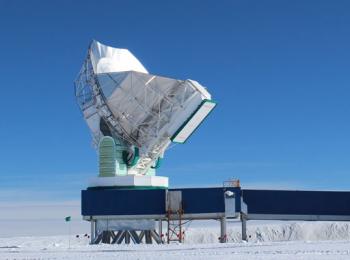 Courtesy of Dan Marrone, University of Arizona Astronomers building an Earth-sized virtual telescope capable of photographing the event horizon of the black hole at the center of our Milky Way have extended their instrument to include the University of Chicago-built South Pole Telescope. The South Pole Telescope, situated at the National Science Foundation's Amendsen-Scott South Pole Station, now is part of the largest virtual telescope ever built - the Event Horizon Telescope. By combining telescopes across the Earth, the Event Horizon Telescope will take the first detailed pictures of black holes. "We are thrilled that the South Pole Telescope is part of the EHT. The science, which addresses fundamental questions of space and time, is as exciting to us as peering back to the beginning of the universe," said UChicago Prof. John Carlstrom, who leads the SPT collaboration. The Event Horizon Telescope is an array of radio telescopes connected using a technique known as Very Long Baseline Interferometry. Larger telescopes can make sharper observations, and interferometry allows multiple telescopes to act like a single telescope as large as the separation, or "baseline," between them. Now that the technique has been extended to the South Pole Telescope, the Event Horizon Telescope spans the entire Earth, from the Submillimeter Telescope on Mount Graham in Arizona, to California, Hawaii, Chile, Mexico, Spain and the South Pole. Read more >> Related Links: KICP Members: John E. Carlstrom Scientific projects: South Pole Telescope (SPT) Absence of gravitational-wave signal extends limit on knowable universe Fermilab, April 27, 2015 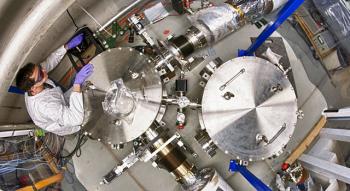 Photo: Reidar Hahn Imagine an instrument that can measure motions a billion times smaller than an atom that last a millionth of a second. Fermilab's Holometer is currently the only machine with the ability to take these very precise measurements of space and time, and recently collected data has improved the limits on theories about exotic objects from the early universe. Our universe is as mysterious as it is vast. According to Albert Einstein's theory of general relativity, anything that accelerates creates gravitational waves, which are disturbances in the fabric of space and time that travel at the speed of light and continue infinitely into space. Scientists are trying to measure these possible sources all the way to the beginning of the universe. The Holometer experiment, based at the Department of Energy's Fermilab, is sensitive to gravitational waves at frequencies in the range of a million cycles per second. Thus it addresses a spectrum not covered by experiments such as the Laser Interferometer Gravitational-Wave Observatory, which searches for lower-frequency waves to detect massive cosmic events such as colliding black holes and merging neutron stars. "It's a huge advance in sensitivity compared to what anyone had done before," said Craig Hogan, director of the Center for Particle Astrophysics at Fermilab. This unique sensitivity allows the Holometer to look for exotic sources that could not otherwise be found. These include tiny black holes and cosmic strings, both possible phenomena from the early universe that scientists expect to produce high-frequency gravitational waves. Tiny black holes could be less than a meter across and orbit each other a million times per second; cosmic strings are loops in space-time that vibrate at the speed of light. The Holometer is composed of two Michelson interferometers that each split a laser beam down two 40-meter arms. The beams reflect off the mirrors at the ends of the arms and travel back to reunite. Passing gravitational waves alter the lengths of the beams' paths, causing fluctuations in the laser light's brightness, which physicists can detect. The Holometer team spent five years building the apparatus and minimizing noise sources to prepare for experimentation. Now the Holometer is taking data continuously, and with an hour's worth of data, physicists were able to confirm that there are no high-frequency gravitational waves at the magnitude where they were searching. The absence of a signal provides valuable information about our universe. Although this result does not prove whether the exotic objects exist, it has eliminated the region of the universe where they could be present. "It means that if there are primordial cosmic string loops or tiny black hole binaries, they have to be far away," Hogan said. "It puts a limit on how much of that stuff can be out there." Detecting these high-frequency gravitational waves is a secondary goal of the Holometer. Its main purpose is to determine whether our universe acts like a 2-D hologram, where information is coded into two-dimensional bits at the Planck scale, a length around ten trillion trillion times smaller than an atom. That investigation is still in progress. "For me, it's gratifying to be able to contribute something new to science," said researcher Bobby Lanza, who recently earned his Ph.D. conducting research on the Holometer. He is the lead author on an upcoming paper about the result. "It's part of chipping away at the whole picture of the universe." Read more >> Related Links: KICP Members: Craig J. Hogan; Stephan S. Meyer Live Session with Michael Turner Livestream.com, May 1, 2015 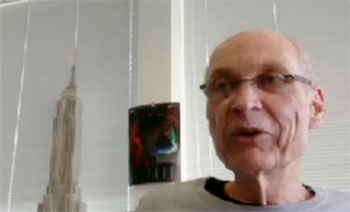 World Science U Master Class with Michael Turner Tue Mar, 10 2015 2PM - 3PM (CDT) Michael Turner, theoretical cosmologist and Director of the Kavli Institute for Cosmological Physics at the University of Chicago, leads a free Master Class focusing on dark energy. The class is part of World Science U's Master Class offering - giving you the opportunity to learn directly from the world's greatest thinkers. Professor Turner hosted a live online session on March 10th, 2015 to answer your questions and delve deeper into the material. Read more >> Related Links: KICP Members: Michael S. Turner Historic AAAS Kavli Competition Expands to Honor Excellence in Science Journalism Worldwide The American Association for the Advancement of Science, May 5, 2015  The American Association for the Advancement of Science (AAAS) today announced a global expansion of its historic science journalism awards program, thanks to an additional generous endowment from The Kavli Foundation. For the first time in its 70-year history, the AAAS Kavli Science Journalism Awards program will this year accept entries from reporters working worldwide. Endowed by The Kavli Foundation in 2009, this year's doubling of the program endowment will further allow AAAS to bestow 16 instead of eight prizes annually. The value of top (Gold) awards will be increased from $3,500 to $5,000, and a $3,500 Silver prize has been added to each of the eight reporting categories. A premier competition of its type, the AAAS Kavli Science Journalism Awards program is widely recognized as an apex achievement for reporters covering the sciences, engineering and mathematics for a general audience. The contest is administered by AAAS, but independent panels of journalists select the winners. With the decision to accept international entries across all categories beginning with the 2014-15 competition cycle, the program is now believed to be the only truly general-interest, reporter-juried science journalism contest open to reporters from around the world. "Like scientific discovery, excellent science journalism can happen anywhere in the world," said AAAS CEO Rush Holt, executive publisher of the Science family of journals. "By recognizing the world's best science news-reporting, AAAS and The Kavli Foundation are working to build a culture of respect for the value of science journalism to society, while promoting public understanding of science more broadly." "The Kavli Foundation is committed to science journalism, and to public understanding and support of science. We are delighted to support the expansion of the AAAS Kavli Science Journalism Awards and to making them international in scope. Our commitment reaffirms all that the AAAS-Kavli partnership has come to reflect: no-strings-attached support for the highest possible standards in science journalism," said Robert W. Conn, President and CEO, The Kavli Foundation. "We are also pleased this expansion is happening now. In the United States and worldwide today, there is an unprecedented need for excellence in science journalism, which is essential to help the public understand and trust scientific results, and how science is shaping our lives." To date, the awards have been given to more than 330 professional journalists for distinguished science news-reporting. The awards program was established in 1945 by the Westinghouse Educational Foundation through the initiative of Robert D. Potter, the president of the National Association of Science Writers. AAAS was asked to administer the program, which was meant to encourage good science journalism at a time when very few news outlets had full-time science writers. Westinghouse continued its support of the program until 1993. The Whitaker Foundation funded the awards from 1994 to 2003. From 2004 to 2008, Johnson & Johnson Pharmaceutical Research and Development, L.L.C. sponsored the awards, including the establishment in 2005 of the first category open to journalists from around the world: reporting on science news for children. In February 2009, The Kavli Foundation, based in Oxnard, California, provided an initial $2 million endowment to AAAS, ensuring the future of the awards program. The Kavli Foundation endowment also made it possible for AAAS to establish two prizes in the television category, for spot news/feature reporting as well as in-depth reporting. Now in 2015, an additional $2 million expansion of the original Kavli Foundation endowment will make it possible for AAAS to open up each prize category to journalists worldwide. Entries for this year's competition are being accepted today through 1 August 2015 in eight categories: large newspaper, small newspaper, magazine, television spot news/feature reporting, television in-depth reporting, radio, online, and children's science news. Independent screening and judging committees evaluate submissions based on scientific accuracy, initiative, originality, clarity of interpretation, and value in fostering a better public understanding of science and its impact. Decisions made by the committees of reporters and editors will be final. Recent winners of the AAAS Kavli Science Journalism Awards have reported on the complexities of human biology, the enduring challenge of understanding cancer, a massive dam-removal project, issues raised by the era of personal genomics, climate-change impacts, endangered species, and many science-based topics with broad implications for society. About AAAS The American Association for the Advancement of Science (AAAS) is the world's largest general scientific society and publisher of the journal Science as well as Science Translational Medicine, Science Signaling, and a new digital, open-access journal, Science Advances. AAAS was founded in 1848 and includes nearly 250 affiliated societies and academies of science, serving 10 million individuals. Science has the largest paid circulation of any peer-reviewed general science journal in the world. The non-profit AAAS is open to all and fulfills its mission to "advance science and serve society" through initiatives in science policy, international programs, science education, public engagement, and more. For the latest research news, log onto EurekAlert!, the premier science-news Web site, a service of AAAS. About The Kavli Foundation The Kavli Foundation is dedicated to advancing science for the benefit of humanity, promoting public understanding of scientific research, and supporting scientists and their work. The Foundation's mission is implemented through an international program of research institutes and scientific meetings in the fields of astrophysics, nanoscience, neuroscience, and theoretical physics, and through the support of conferences, symposia, endowed professorships and other activities. The Foundation also supports initiatives aimed at strengthening science journalism and also the communication of science, including the AAAS Kavli Science Journalism Awards, the Kavli Science Journalism Workshops at MIT and the Alda Kavli Leadership Program at Stony Brook University. The Foundation is a founding partner of the biennial Kavli Prizes, which recognize scientists for their seminal advances in three research areas: astrophysics, nanoscience, and neuroscience. Read more >> The Particle That Broke a Cosmic Speed Limit Quanta Magazine, May 17, 2015 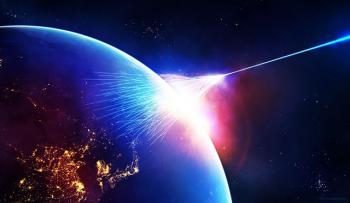 Physicists are beginning to unravel the mysteries of ultrahigh-energy cosmic rays, particles accelerated by the most powerful forces in the universe. In the night of October 15, 1991, the "Oh-My-God" particle streaked across the Utah sky. A cosmic ray from space, it possessed 320 exa-electron volts (EeV) of energy, millions of times more than particles attain at the Large Hadron Collider, the most powerful accelerator ever built by humans. The particle was going so fast that in a yearlong race with light, it would have lost by mere thousandths of a hair. Its energy equaled that of a bowling ball dropped on a toe. But bowling balls contain as many atoms as there are stars. "Nobody ever thought you could concentrate so much energy into a single particle before," said David Kieda, an astrophysicist at the University of Utah. Five or so miles from where it fell, a researcher worked his shift inside an old, rat-infested trailer parked atop a desert mountain. Earlier, at dusk, Mengzhi "Steven" Luo had switched on the computers for the Fly's Eye detector, an array of dozens of spherical mirrors that dotted the barren ground outside. Each of the mirrors was bolted inside a rotating "can" fashioned from a section of culvert, which faced downward during the day to keep the sun from blowing out its sensors. As darkness fell on a clear and moonless night, Luo rolled the cans up toward the sky. "It was a pretty crude experiment," said Kieda, who operated the Fly's Eye with Luo and several others. "But it worked - that was the thing." The faintly glowing contrail of the Oh-My-God particle (as the computer programmer and Autodesk founder John Walker dubbed it in an early Web article) was spotted in the Fly's Eye data the following summer and reported after the group spent an extra year convincing themselves the signal was real. The particle had broken a cosmic speed limit worked out decades earlier by Kenneth Greisen, Georgiy Zatsepin and Vadim Kuzmin, who argued that any particle energized beyond approximately 60 EeV will interact with background radiation that pervades space, thereby quickly shedding energy and slowing down. This "GZK cutoff" suggested that the Oh-My-God particle must have originated recently and nearby - probably within the local supercluster of galaxies. But an astrophysical accelerator of unimagined size and power would be required to produce such a particle. When scientists looked in the direction from which the particle had come, they could see nothing of the kind. "It's like you've got a gorilla in your backyard throwing bowling balls at you, but he's invisible," Kieda said. Where had the Oh-My-God particle come from? How could it possibly exist? Did it really? The questions motivated astrophysicists to build bigger, more sophisticated detectors that have since recorded hundreds of thousands more "ultrahigh-energy cosmic rays" with energies above 1 EeV, including a few hundred "trans-GZK" events above the 60 EeV cutoff (though none reaching 320 EeV). In breaking the GZK speed limit, these particles challenged one of the farthest-reaching predictions ever made. It seemed possible that they could offer a window into the laws of physics at otherwise unreachable scales - maybe even connecting particle physics with the evolution of the cosmos as a whole. At the very least, they promised to reveal the workings of extraordinary astrophysical objects that had only ever been twinkles in telescope lenses. But over the years, as the particles swept brushstrokes of light across sensors in every direction, instead of painting a telltale pattern that could be matched to, say, the locations of supermassive black holes or colliding galaxies, they created confusion. "It's hard to explain the cosmic-ray data with any particular theory," said Paul Sommers, a semiretired astrophysicist at Pennsylvania State University who specializes in ultrahigh-energy cosmic rays. "There are problems with anything you propose." Only recently, with the discovery of a cosmic ray "hotspot" in the sky, the detection of related high-energy cosmic particles, and a better understanding of physics at more familiar energies, have researchers secured the first footholds in the quest to understand ultrahigh-energy cosmic rays. "We're learning things very rapidly," said Tim Linden, a theoretical astrophysicist at the University of Chicago. Read more >> Related Links: KICP Members: Toshihiro Fujii; Tim Linden; Angela V. Olinto; Paolo Privitera KICP Students: Ke Fang Scientific projects: Pierre Auger Observatory (AUGER) UChicago celebrates the promise of Chicago youth The University of Chicago News Office, May 25, 2015  Though Daweed Abdiel always has been intellectually curious and a good student, college wasn't always on his radar. Most of his older family members had started college but never finished. In his first two years of high school, "I wasn't thinking about college too much," he said. "I was a good student, but I had no direction." That changed after Abdiel joined the Upward Bound program offered through the Office of Special Programs-College Prep. Staff members who lead the program encouraged him to apply to colleges. "This program helped me determine I wanted a small liberal arts college." With Upward Bound showing the way, he got what he wanted. In August, Abdiel will attend Denison University with the support of two prestigious awards: a Gates-Millennium Scholarship and a Posse Scholarship. "We have young people who develop a real sense of confidence and self-awareness about who they are and their ability to meet challenges and be successful," said Dovetta McKee, director of the Office of Special Programs-College Prep. "It changes their mindset about the leadership role they can play in their communities, and makes them models for young people who follow behind them," she said. Abdiel was one of about 60 Chicago high school seniors honored at the 2015 Student Recognition Night, sponsored by the Office of Civic Engagement. The seniors took part in one of two programs: Upward Bound or the Collegiate Scholars Program, which prepares talented Chicago Public Schools students to succeed in the nation's top colleges and universities. In addition, University students who have served with the Neighborhood Schools Program received recognition for their work in local public schools and community programs. All three efforts are part of UChicago Promise, the University's multi-pronged effort to increase college access and success for Chicago youth. Increasing college access and success starts young. The Neighborhood Schools Program connects 375 UChicago students with 3,000 students in the surrounding neighborhoods. Many are still grade-schoolers, and tutoring can make a real impact on their future prospects. "We leaned on NSP quite a lot and they came through," said Ed Kajor in a video shown at the event. Kajor, a learning behavior specialist at Burke Elementary in Washington Park, credits tutoring from volunteers like Amanda Weisler, a third-year sociology major, for boosting the school's scores on standardized tests. "Our program is one of a few that is truly receptive to local school needs, said Shaz Rasul, director of community programs in the Office of Civic Engagement. "If a principal tells us she needs help with third grade, we will find tutors for the third grade who can be available during the school day. This is important because schools are often judged by what happens in the classroom, not enrichment time after school." University students benefit, too. Real-world experience has led more than one NSP volunteer into a career in education, from Sara Stoelinga, who was honored at the event with the Don York Faculty Initiative Award, to keynote speaker Geoffrey Aladro AB'06, who is currently Miami-Dade's Teacher of the Year. When Aladro discovered his long-held dream of corporate work wasn't all he thought it would be, he changed gears and chose teaching because of his NSP experiences. "I haven't really worked since I became a teacher," he told the crowd, "because I love my work." Fourth-year Jonathan Fifer, who volunteered with NSP throughout his College career, intends to follow in their footsteps. His next goal will be to earn a master's degree from Teachers College, Columbia University, where he'll study early childhood education. "I've always been interested in the little kids," he said. "Even when they're crying or being bad, you can see their thought process. I can't be mad at them." While teaching high school students about the college application process gets them started on their higher education journey, the Upward Bound and Collegiate Scholars programs also support young people's intellectual growth. Ivelise Colon, a Collegiate Scholar, has chosen Whittier College's alternative liberal arts program, where she will design her own major, incorporating elements of psychology, sociology and early childhood education. "I want to do my own thing," she said. "The hallmark of Collegiate Scholars is the interaction with faculty. We are one of very few institutions in the country where there is intentional engagement between University faculty and public school students from across the city," said Abel Ochoa, interim director of the Collegiate Scholars Program. "It really elevates a student's frame of thinking to be taught by a professor who has written a textbook, done concrete research, or is considered a world-renowned expert in his field." Like Colon, Abdiel has seen his intellectual interests shift over time, from physics to chemistry with a generous side helping of economics and African-American Studies. He credits his Upward Bound mentors for exposing him to the Kavli Institute of Cosmological Physics and for staying the course with him as his interests evolved. "They won't tell you what to do, but they'll ask you questions," he said. "They'll help you find your passions." Read more >> Related Links: KICP Members: Randall H. Landsberg; Donald G. York Students in arts and sciences influence, benefit each other The University of Chicago News Office, May 29, 2015 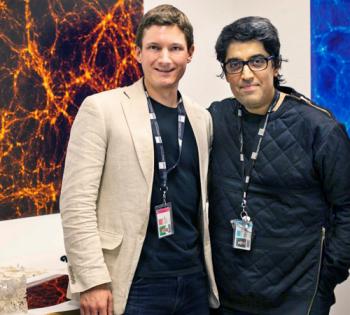 This year, in a new partnership with the School of the Art Institute of Chicago, the Arts, Science & Culture Initiative awarded grants to five teams composed of nine UChicago and three SAIC graduate students. The goal of providing these collaborative grants is "to test the idea that different domains of knowing and knowledge -- arts, science and culture -- can enrich and influence each discipline's particular questions, tools, methodologies and specific curiosities," said Julie Marie Lemon, the program's director and curator. The collaborative efforts between the students of arts, science and culture resulted in creative projects that were presented in early May. One of the projects was "The Fabric of the Universe," created by Isaac Facio, a master of fine arts candidate in fiber and material studies at SAIC, and Benedikt Diemer, a UChicago PhD candidate in astrophysics. This project used computer simulations of dark matter and translated them into a more tangible form using three-dimensional textiles, resulting in a novel way of visualizing the structure of the universe. Diemer said that the project has offered a new perspective for his research in astrophysics. "Our project has caused me to look at my data in 3-D where I previously only made 2-D visualizations. This has definitely improved my understanding of the dark matter structures in my simulations," he said. As a testament to the novel insights offered by this project, "'The Fabric of the Universe' was awarded a grant from the renowned TextielLab, part of the TextielMuseum, in Tilburg, the Netherlands, to produce the fabric," said Lemon, the program director. And each year, Lemon noted, "the collaborations and the projects have become more and more sophisticated, and more students become interested in the initiative." Read more >> Related Links: KICP Students: Benedikt Diemer Honoring graduate teachers and mentors: Prof. Angela Olinto The University of Chicago News Office, June 1, 2015 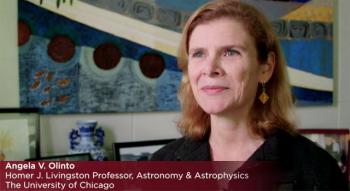 Homer J. Livingston Professor, Astronomy & Astrophysics The 2015 Faculty Award for Excellence in Graduate Teaching and Mentoring Angela V. Olinto Homer J. Livingston Professor, Astronomy & Astrophysics When Angela Olinto entered graduate school in physics at the Massachusetts Institute of Technology in 1982, there were two women and 60 men in her class. But over her 21 years at the University of Chicago, Olinto has welcomed 10 women and five men as graduate students into her research group, which specializes in particle astrophysics and cosmology. "It's thrilling to look back and realize I've had about 70 percent women in my group, which is not something I planned," Olinto says. "It's been a colorful and brilliant group, lots of different nationalities and personalities, lots of different points of view. I've always learned as much from them as I taught them." Olinto's students now have dispersed across the country and around the world. But many of them came together via email to nominate Olinto for the Faculty Award for Excellence in Graduate Teaching and Mentoring. Coordinating the effort was Olinto's current graduate student, Ke Fang, who graduates this summer. "Independent of actually receiving the award, just the nomination itself was a great honor to me," Olinto says. Read more >> Related Links: KICP Members: Angela V. Olinto KICP Students: Ke Fang Prof. Daniel Holz receives Quantrell Award The University of Chicago News Office, June 1, 2015  The Llewellyn John and Harriet Manchester Quantrell Awards are believed to be the nation's oldest prize for undergraduate teaching. Presented annually, the awards reflect the College's commitment to honoring inspiring teachers. UChicago faculty often count the Quantrell among their most treasured honors. "Ernest Quantrell, who first established the Quantrell Awards in 1937, wanted to honor faculty members who were great scholar-teachers and who inspired our students to become more enlightened thinkers and more effective citizens of their communities and of our nation," says John W. Boyer, dean of the College. "As teachers and as scholars and as citizens of the University at large, this year's Quantrell winners exemplify the very best about the College and the University." Daniel Holz, Associate Professor, Physics Soon after Daniel Holz learned of his Quantrell Award, he looked up the list of previous recipients. "I was actually a graduate student here at UChicago, and I've had some of the previous recipients as professors. They're truly outstanding," says Holz, PhD'98, an associate professor in physics. "It's really an honor to be on the same list." Read more >> Related Links: KICP Members: Daniel E. Holz 2015 Gruber Prize in Cosmology: John E. Carlstrom The Gruber Foundation, June 9, 2015 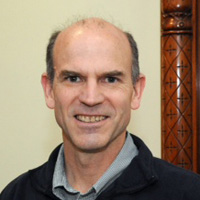 The 2015 Gruber Prize in Cosmology honors theorist Jeremiah P. Ostriker for his lifetime of achievements and the experimentalists John E. Carlstrom and Lyman A. Page, Jr., for their pioneering observations of the cosmic microwave background (CMB), the relic radiation from the infancy of the universe's existence. Individually and collectively the works of these three scientists has helped to establish and advance the standard cosmological model: a universe that arose out of an inconceivably dense state of matter and energy, and has been expanding and cooling ever since, eventually coalescing into today's familiar skyscape of planets, stars, and galaxies. During a five-decade career at Princeton University, Jeremiah Ostriker has made significant contributions to the studies of galaxy formation, the interstellar medium, and the intergalactic medium. He has also repeatedly challenged assumptions about how the universe works and proposed radical alternative interpretations. In 1972 he and Princeton colleague P. James E. Peebles created computer simulations that indicated either Newton's law of gravitation is wrong or some sort of invisible mass must be present to stabilize rotating spiral galaxies such as our own Milky Way. A year later, in collaboration with a postdoctoral fellow, Ostriker and Peebles surveyed existing data from a wide array of observations of individual galaxies and clusters of galaxies and concluded, in the opening sentence of a now-classic paper: "There are reasons, increasing in number and quality, to believe that the mass of ordinary galaxies may have been underestimated by a factor of 10 or more." In 1995, Ostriker and another Princeton colleague, Paul J. Steinhardt, argued that the total amount of matter in the universe, dark or otherwise, is at odds with some key theoretical implications of the Big Bang interpretation of the universe. Ostriker and Steinhardt invoked yet another mysterious missing component that they said should be permeating the universe. Today we call the missing components that Ostriker proposed in the 1970s and 1990s dark matter and dark energy, respectively -- abstract ideas that have been borne out by innumerable observations. In fact, while other theorists were making arguments similar to that of Ostriker and Steinhardt in the mid-1990s, what distinguishes their paper is the suggestion that this component should contribute about 70 percent to the total mass and energy of the universe --a figure validated by many later observations, including those made by the instruments overseen by Carlstrom and Page. While both Page and Carlstrom have worked extensively in the study of the CMB, they lead two projects in particular. Carlstrom, who has been at the University of Chicago since 1995, is the principal investigator on the South Pole Telescope, which was constructed at the U. S. science station at the Pole in late 2006 and early 2007. Page, who has been at Princeton since 1990, serves in the same capacity for the Atacama Cosmology Telescope, which was constructed on Cerro Toco in the mountainous Atacama Desert in Chile in 2007. Those instruments, both still active, probe the CMB, the relic radiation dating to the infancy of the cosmos. When the universe was 380,000 years old it had cooled enough for hydrogen atoms and photons to decouple and go their separate ways. That "flashbulb" moment has survived as a sort of snapshot -- a "baby picture" of the universe-- though over the past 13.7 billion years the expansion of space has stretched the light from the image all the way into the microwave end of the electromagnetic spectrum. Look closely enough and finely enough at the CMB, though, and you should be able to see extraordinarily subtle shadings in temperature: the DNA for the galaxies, clusters of galaxies, and super-clusters of galaxies that populate the universe as we know it. Among the many contributions to cosmology that the South Pole Telescope and the Atacama Cosmology Telescope have made are: the discovery of hundreds of clusters of galaxies going back to when the universe was about one-third its present age, providing a history of the growth of the large-scale structure of the universe; independent verification that the universe consists of approximately 25 percent dark matter, 70 percent dark energy, and 5 percent atoms; and strong evidence that the structure in the CMB is a remnant of quantum fluctuations. This latter data is in excellent agreement with the model of inflation, a theoretical primordial hyper-expansion of space that would have determined the distribution of all that energy and matter. What is dark matter? What is dark energy? How to explain a quantum universe? In honoring Carlstrom, Ostriker, and Page, the 2015 Gruber Cosmology Prize recognizes science doing what science does best: answering fundamental questions while opening new frontiers for observers and theorists alike and raising new fundamental questions to puzzle us. Read more >> Related Links: KICP Members: John E. Carlstrom Scientific projects: South Pole Telescope (SPT) John Carlstrom to receive Gruber Cosmology Prize for experimental explorations of universe The University of Chicago News, June 11, 2015  The 2015 Gruber Foundation Cosmology Prize has honored the University of Chicago's John E. Carlstrom, alumnus Jeremiah P. Ostriker, PhD'64, and Princeton University's Lyman Page for their individual and collective contributions to the study of the universe on the largest scales. The 2015 prize is divided into two parts: half to a distinguished theorist, and the other half to two exceptional experimentalists. The theorist is Ostriker, a professor emeritus at Princeton University, now teaching at Columbia University. Ostriker, whose graduate school mentor was UChicago Nobel laureate Subrahmanyan Chandrasekhar, is being honored for his groundbreaking body of work over a five-decade career. Carlstrom, the S. Chandrasekhar Distinguished Service Professor in Astronomy & Astrophysics, and Page, the Henry De Wolf Smyth Professor of Physics, have each overseen ground-based experiments that have provided a wealth of information about the origins and evolution of the universe. Carlstrom has worked extensively to study the cosmic microwave background, the relic radiation from the infancy of the universe, using the South Pole Telescope and other instruments. "Together, the theoretical and experimental work of these three scientists has contributed to, clarified and advanced today's standard cosmological model," the Gruber Foundation wrote in announcing this year's prize. Ostriker will receive half of the $500,000 award, while Carlstrom and Page will divide the other half. All three also will receive a gold medal Aug. 3 at the XXIX General Assembly of the International Astronomical Union in Honolulu, Hawaii. Previous recipients of the Gruber Prize include Wendy Freedman, the University Professor in Astronomy & Astrophysics, who received the 2009 prize "for the definitive measurement of the rate of expansion of the universe, Hubble's Constant." One of the foremost awards in the field of cosmology, the prize honors "a leading cosmologist, astronomer, astrophysicist or scientific philosopher for theoretical, analytical, conceptual or observational discoveries leading to fundamental advances in our understanding of the universe," according to the Gruber Foundation. Stephan Meyer, professor in astronomy & astrophysics, received a share of the prize in 2006 as a member of the Cosmic Background Explorer Team "for studies confirming that our universe was born in a hot Big Bang." He repeated the feat in 2012 as a member of the Wilkinson Microwave Anistropy Probe, which was honored for "exquisite measurements of anisotropies in the relic radiation from the Big Bang - the Cosmic Microwave Background." Read more >> Related Links: KICP Members: John E. Carlstrom; Stephan S. Meyer Scientific projects: South Pole Telescope (SPT) MIRA and marathons Argonne, June 18, 2015  For three Argonne employees it's all about speed - both in and out of the lab. Katrin Heitmann, a joint staff member in the High Energy Physics and Math and Computer Sciences Divisions; Salman Habib, senior physicist in the High Energy Physics and Math and Computer Sciences Divisions and Steve Rangel, lab appointee and Ph.D. student at Northwestern University have run the largest cosmological simulation on MIRA - one of the world's fastest supercomputers. Their aim was to create high-resolution simulations what would allow scientists to connect numerous surveys of the universe that measure the distribution of galaxies. "Dealing with data is a big challenge in and of itself. What a large computer like MIRA enables is a lot of statistics." - Katrin Heitmann, Staff Member HEP and MCS MIRA is capable of 10 quadrillion calculations per second. Located at the Argonne Leadership Computing Facility, it can do in one day what it would take the average personal computer 20 years to complete. MIRA is also what brought Heitmann and Habib to Argonne from Los Alamos National Laboratory in Los Alamos, New Mexico. Rangel joined the team soon after their move to Argonne. He said he first became interested in data science and data analysis when he was pursuing his master's degree. Later, his interest evolved into a passion for high performance computing. "It was sort of a natural fit to come here and work with Salman and Katrin's group." - Steve Rangel, Ph.D. student at Northwestern University The team has now begun to analyze the simulations, measuring galaxy distribution from a theory standpoint and comparing that data to observations of the universe. The team worked together to transform data from the MIRA simulation into an image that closely resembles the actual universe. Argonne joint staff member Nan Li and University of Chicago Professor Mike Gladders constructed the final visualization. But besides performing the world's biggest simulation on MIRA, the team will put their own speed to the test later this year when they run the Bank of America Chicago Marathon. The team ran together for the first time in this year's Bank of America Shamrock Shuffle, held March 29 in downtown Chicago. Rangel then suggested they run a marathon. "At first I said, 'No way!'" Heitmann said. "Then, I got to thinking about it and thought it would be kind of cool if our group did it together. But I said we should at least do it for something more meaningful than just suffering for 26 miles." With that idea in mind, Heitmann said she searched for charities listed on the Chicago Marathon website for which people can run. There, she found Chicago HOPES for Kids. HOPES began in 2006 as an initiative of the Chicago Public Schools Department of Education Support for Students in Temporary Living Situations, or STLS. The organization collaborates with schools and shelters to establish after-school tutoring programs and provides students with additional support outside the classroom despite the challenges of homelessness, according to their website. Heitmann and Habib will be running the marathon as part of the organization's team Hustle for Hopes. The money raised is used to purchase educational materials for the students. "I like to support something local, that I can actually go see the students and meet with these people," Heitmann said. Rangel will be running with the Chicago Area Runners Association (CARA) Road Scholars - a mentorship-based running program for at-risk Chicago area high school students. Mentors train students to successfully complete a half-marathon. The program also uses running to teach at-risk youth lessons in commitment, dedication and discipline, according to the CARA website. Funds raised by the marathon participants will be used to provide teens in the program with running shoes, transportation to training sites and cover race entry fees. "I was lucky enough to start running when I was a kid," Rangel said. "For me, it really hits home." The 26.2-mile marathon is scheduled to be held October 11 in downtown Chicago. Read more >> Related Links: KICP Members: Michael D. Gladders; Salman Habib; Katrin Heitmann Chicago blues and the science in sound The University of Chicago News Office, June 19, 2015  'Science and Sound' Preview Video Everyone knows about visualizing data, but few have heard of sonifying data. Nevertheless, sound has great potential for organizing, interpreting and sharing scientific knowledge. Sound can also be a powerful tool to learn more about culture and the natural world. Citing microbial bebop, Chicago blues, cosmic sound and a string quartet inspired by DNA's double helix, panelists at a program called "Science and Sound" on June 3 made a strong case for exploring and exploiting sound as a tool in scientific endeavors. The occasion was the 11th in a series of joint speaker events for faculty at the University of Chicago as well as scientists, researchers and engineers at Argonne National Laboratory and Fermi National Accelerator Laboratory. It was held at Buddy Guy's Legends, the "cathedral" of Chicago blues and the "perfect place to discuss how sound serves science, pervades our lives and influences our emotions," said Donald Levy, vice president for Research and for National Laboratories at the University of Chicago. Panelist Peter Larsen, assistant computational biologist at Argonne, explained how an algorithm he calls microbial bebop generates data into music by normalizing the data to a dynamic range of integer values and mapping those values to notes and chords. "I doubt that I'll ever come up with a composition that will change my understanding of microbial ecology, but the very exercise of doing this has already accomplished that," he said. "My job is to think of interesting ways to analyze big data... and microbial bebop has helped me find and understand better approaches to understanding data." Another panelist, however, decided not to transcribe data directly into music, realizing that such an approach would not create an effective, cohesive composition. In composing "Helix Spirals" for string quartet, Grammy-winning composer Augusta Read Thomas, University Professor of Composition, approached the project metaphorically. She found inspiration in science and showed how well music can present an abstract and intellectual expression of nature. "Helix Spirals" celebrates the Meselson-Stahl DNA replication experiment of 1958. The first movement, Thomas explained, portrays loci, that is, specific but "flickering" locations of genes or DNA sequences on a chromosome. The second movement portrays DNA replication with different instruments representing different strands. And the third conveys the beauty, richness and force of life. "Nature is a great teacher of transformation, connections and, for me, music composition," said Thomas, who is now working on a piece about protein folding. Indeed, music and sound is a "metaphor for the regularity of nature and even the movement of the heavens," said moderator Sidney Nagel, the Stein-Freiler Distinguished Service Professor in Physics. Listening to learn Instead of using science to generate or inspire music, panelist Michael Dietler, professor in anthropology, works the other way around. He listens to music to better understand cultures. "Music is a socially patterned, cultural phenomenon, and the blues has a lot to teach us about Chicago's African American culture," he said. Noting that many students spend four years on campus without exploring what Chicago has to offer, Dietler created a course on the history of the blues, which he called an enormously influential form of music. "It's one thing to listen to the blues and quite another to understand how it evolved, impacts people, influences culture and continues to develop today," Dietler said. The difference is akin, he added, to the difference between enjoying the sound of French and actually understanding what is being said, idiomatically, historically and culturally. Meanwhile, one of the best ways to learn about the universe is to listen to it. "Just like you can learn a lot about an instrument by studying the frequency of the sound it makes, you can learn a lot about the content of the universe by studying the Cosmic Microwave Background," said Bradford Benson, associate scientist and Wilson fellow at Fermilab and assistant professor in astronomy and astrophysics at the University of Chicago. Cosmic Microwave Background is radiation left over from the Big Bang. "As we map the sky, we can detect sound waves from the early history of the universe, more than 13 billion years ago," Benson said. "When we measure the Cosmic Microwave Background's power spectrum - analogous to what you might do with a stereo amplifier - we find a remarkable harmonic structure," Benson said. Overall, the panelists agreed that sound and science go well together, whether it is to listen to the cosmos - and each other - or to utilize sound as a tool to understand data and present knowledge, directly or indirectly. For instance, although microbial bebop is not an effective way to share data, it is a great way to engage students in science, Larsen has found. But the day may come when sonified data and audible pie charts are as commonplace as visual maps. "We have to learn how to create and interpret charts, Venn diagrams, and other visual presentations of data," Dietler said. "Likewise, we could learn how to utilize sound and music more in science. We're used to conducting many things visually, but there's no reason why we couldn't handle more things audibly." "Some of what we learn is communicated through sound, but there's a big potential to tap sound in new ways to achieve much more," Nagel concluded. Read more >> Related Links: KICP Members: Bradford A. Benson Kavli Roundtable Discussion: "Dwarf Galaxies Loom Large in the Quest for Dark Matter" The Kavli Foundation, June 24, 2015 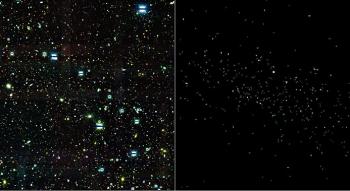 A batch of newly discovered satellite dwarf galaxies orbiting the Milky Way should help scientists better grasp the evolution of the universe while also honing in on dark matter's identity. IN ITS INAUGURAL YEAR OF OBSERVATIONS, the Dark Energy Survey has already turned up at least eight objects that look to be new satellite dwarf galaxies of the Milky Way. These miniature galaxies - the first discovered in a decade - shine with a mere billionth of our galaxy's brightness and each contains a million times less mass. Astronomers believe the vast majority of material in dwarf galaxies is dark matter, a mysterious substance composing about 80 percent of all matter in the universe. Dwarf galaxies have therefore emerged as prime targets for gathering potential clues about dark matter's composition. Some theories suggest dark matter particles and antiparticles should produce telltale gamma rays when they collide with each other. Accordingly, scientists used the Fermi Gamma-Ray Space Telescope to study the newfound dwarf galaxy candidates, as well as a group of dwarf galaxies already on the books. The telescope detected no significant gamma-ray signals from either set of dwarf galaxies, however, leaving scientists still in the hunt for dark matter. Four studies earlier this spring from the Dark Energy Survey and Fermi announced this flurry of results. On May 18, 2015, The Kavli Foundation spoke with three astrophysicists about the continuing search for dark matter data in space and how dwarf galaxies can help us understand the evolution of our universe. The participants were:
The following is an edited transcript of their roundtable discussion. The participants have been provided the opportunity to amend or edit their remarks. THE KAVLI FOUNDATION: What were your first thoughts when you saw the signs of these dwarf galaxies in Dark Energy Survey data? ALEX DRLICA-WAGNER: It was very exciting and definitely not something you get to experience every day. It was obvious from the start that some of the objects in the data were real stellar systems and very probable that they were new dwarf galaxies. JOSH FRIEMAN: We released the first year of Dark Energy Survey data internally to our international collaboration of scientists in late December. Within a week or two, Alex and his co-lead author, Keith Bechtol, who is a postdoctoral research fellow at the Kavli Institute for Cosmological Physics, helped to lead the group of Dark Energy Survey scientists who identified these objects. Alex and Keith had spent a long time developing methods for detecting dwarf galaxies in this data, so when it became available they were instantly able to jump on it. DRLICA-WAGNER: When you see something like this emerge from your data analysis for the first time, that's very special. You've invested so much time going through all of the data, you can feel a little lost down there in all the details. ANDREA ALBERT: Yeah, I know how that feels! TKF: How did the Dark Energy Survey enable the discovery of these dwarf galaxies? FRIEMAN: We didn't actually build the Dark Energy Survey to do this. These nearby dwarf galaxies are foreground objects to what we're really trying to study, which are hundreds of millions of distant galaxies. We are measuring those distant galaxies' properties and their distribution to figure out why the expansion of the universe is speeding up due to dark energy. We realized that those same data would be very useful not only for studying the distant universe, but also for identifying very faint dwarf satellite galaxies of our own Milky Way. DRLICA-WAGNER: With the Dark Energy Camera, the principal instrument for the Dark Energy Survey, this is the first time we've had a super-sensitive, large-field digital camera in the southern hemisphere. The explosion of dwarf discoveries about a decade ago in the northern hemisphere was made possible because of the state-of-the-art technology involved in the Sloan Digital Sky Survey [SDSS]. With the Dark Energy Camera, we have an even better camera than SDSS and we have a whole new region of sky. FRIEMAN: This is one of those examples where you build something with one goal in mind, but if it's properly designed it turns out to be quite useful for a variety of other scientific studies as well. DRLICA-WAGNER: As Josh just said, the Dark Energy Survey was not intended for this kind of science, but it really presented an amazing opportunity. We were able to find this abundance of new stellar systems by combining two models of what we expect dwarf galaxies to look like. In general, dwarf galaxies have more stars near their centers and fewer stars near their peripheries. Additionally, the stars in dwarf galaxies tend to follow a very distinct pattern of color and brightness. By combining these two models, we had a much better chance of finding dwarf galaxies. TKF: Why are dwarf galaxies so notoriously difficult to spot? DRLICA-WAGNER: Dwarf galaxies are hard to find because they contain very few bright stars. Also, dwarf galaxies are mostly made of dark matter. If we figured out a way to see dark matter, then dwarf galaxies would be easy to see. ALBERT: We're awesome at seeing stars because we are awesome at seeing light. Unfortunately, dark matter does not directly make light. So we call it "dark." Physicists are not that creative when we come up with names! FRIEMAN: One thing astronomers like to do when they're presenting at conferences is to show an image of what a dwarf galaxy looks like. The presenter will show an image and it looks like nothing is there, like a random field of stars. And then on the next slide, the astronomer will circle all the objects that are members of that dwarf galaxy, and then it pops out at you. What you really need to find these dwarf galaxies are very sensitive observations that allow you to detect faint stars and determine their colors. All that is critical for being able to distinguish a grouping of stars that together form a dwarf galaxy from the light of background galaxies and from foreground stars in the Milky Way. ALBERT: I'd also mention that many of the reasons why dwarf galaxies are very, very challenging to detect are also the reasons why they are one of the best targets we have today for dark matter searches. TKF: That comment segues into why dwarf satellite galaxies of the Milky Way are so scientifically valuable. Alex, you've said before that their dark matter content makes them important for both astronomy and physics. Can you elaborate? DRLICA-WAGNER: This long-standing problem of the identity of dark matter is a topic where you historically have seen a lot of interplay between astronomy and physics. Dark matter was first a purely astronomical problem. It was originally discovered by observations showing that the force of gravity is not strong enough to prevent galaxies and clusters of galaxies from flying apart. So astronomy at the very start was sort of telling physics, "Hey, there's something here that we don't understand." In parallel physicists, were coming up with their own ideas for new fundamental particles. Eventually, people started to assemble the idea that missing "dark" matter particles could be holding galaxies together. FRIEMAN: This notion of dark matter particles goes back 35 years or so and it's very compelling. Assume you have an unseen particle that weighs, say, 10 to 100 times the mass of a proton. Say it only rarely interacts with particles of normal matter through a force similar to the "weak force," one of the four known forces of nature. Particles with these properties would very naturally be around in the right amounts in the universe to be the dark matter that we infer in galaxies and clusters of galaxies. The particles would also possess the right properties to explain the formation of galaxies and larger structures. DRLICA-WAGNER: This melding of ideas from astronomy and physics has really come together to make a cosmic frontier of physics. We're trying to push our fundamental understanding of physics through a better understanding of the cosmos with observations like those from the Dark Energy Survey. TKF: Dwarf galaxies and the search for dark matter particles are a prime example of the intersection of astronomy and physics. Andrea, your specialty is looking for the signatures of dark matter particles that hypothetically self-annihilate, rather like how normal matter particles and antimatter particles annihilate each other. This annihilation should generate telltale gamma rays. Yet the Fermi Gamma-Ray Space Telescope hasn't glimpsed gamma-ray signatures from dwarf galaxies, including the newly discovered dwarfs, that are suggestive of dark matter. What is your reaction to this? ALBERT: It is disappointing. I think anyone who says that it's exciting that we haven't discovered particles of dark matter is a liar. [Laughter] So yes, we have not seen dark matter yet. However, we are just starting to scratch the surface. We have calculated a rate at which we expect annihilations to occur, according to various models, and determined what the gamma-ray signature of these annihilations should be. This annihilation rate and its gamma-ray signals are tied to the mass of the dark matter particles. At this point, we have just started to test for the most promising dark matter candidates across a small range of masses. There are models for more massive dark matter particles than we can now detect with Fermi, and which are just as viable. So I think that if dark matter is hiding, we are narrowing in on it, and that's exciting. FRIEMAN: There's a real synergy between the Dark Energy Survey, which is an optical survey of the sky, and the Fermi experiment, which is searching over the whole sky for gamma rays. It has been very exciting putting these two projects together to make progress in constraining dark matter. I agree with Andrea that even though the latest studies report a non-detection of signature gamma rays, it's nevertheless important progress in constraining what the dark matter could be. And I think it's pushing us closer to either detecting dark matter particles or having to go in a different direction to explain dark matter. ALBERT: The search for dark matter reminds me of the history of the search for the Higgs boson, which we finally discovered in 2012 at the Large Hadron Collider [LHC] at CERN. A couple of years before then, we were looking for the Higgs boson in the less powerful Tevatron particle accelerator at Fermilab. An experiment there was one of the first to rule out certain masses of the Higgs boson. That told us we needed to go and build a better accelerator before we would actually find the thing. Fermi's been running for over six years now, but there is a new gamma-ray experiment in the making called the Cherenkov Telescope Array. It is going to be able to test for much heavier dark matter particle masses inaccessible to Fermi. "Many of the reasons why dwarf galaxies are very, very challenging to detect are also the reasons why they are one of the best targets we have today for dark matter searches." - Andrea Albert TKF: How else can dwarf galaxies help us pin down the properties of dark matter? DRLICA-WAGNER: It's worth noting that there are multiple targets in the sky where you'd expect to see a gamma-ray signal from dark matter. One of the most tantalizing is the center of the Milky Way galaxy itself. Unfortunately, the center of our Galaxy is a very active region, and there are loads of gamma rays coming from there. The issue is that when you see these gamma rays, it could just be that you don't fully understand how our Galaxy's center is producing them astrophysically. Or, on the other hand, there could be a dark matter component to the gamma-ray emissions. Dwarf galaxies are extremely important because you can use them as a cross-check on any interesting signals you see from the Galactic center. ALBERT: Interpreting this excess of gamma rays from the Milky Way's center as possibly coming from dark matter annihilations highlights how important it is to have a large sample of these dwarf galaxies. The Galactic center is close to us and it's really bright in gamma rays, whereas these dwarf galaxies are like little, dim candles. So how are we ever going to compare dwarf galaxies to the big, bright Galactic center? If we have enough dwarf galaxies, we can stack up them up statistically for a comparison, so we can then start to test and rule out models that don't fit the data. DRLICA-WAGNER: That's right. While we will likely have a smaller gamma-ray signal from dwarf galaxies, the signal is much cleaner and easier to study than from the very active center of the Milky Way galaxy. "We're trying to push our fundamental understanding of physics through a better understanding of the cosmos with observations like those from the Dark Energy Survey." - Alex Drlica-Wagner TKF: By finding these new satellite dwarf galaxies of the Milky Way, do you think we're closer to solving the so-called missing satellite problem? According to the leading theory of Big Bang cosmology, known as the cold dark matter model, there should be hundreds of satellite dwarf galaxies orbiting the Milky Way. Yet we've only found a few dozen. Are we now starting to plug this gap? FRIEMAN: This has been an interesting problem and it gets into the cosmological issue of the formation of structure in the universe, of how galaxies and galaxy clusters came to be. One of the exciting things about dwarf galaxies is that they are likely some of the first large structures that formed in the universe. In the cold dark matter model, structure forms hierarchically. That means that smaller structures formed first and then merged together to form larger structures, made of both dark matter and galaxies. DRLICA-WAGNER: The population of dwarf galaxies tells us something about how galaxies form. They address larger astrophysical questions about how our galaxy came to be and how other large galaxies form from gathering up the small, original galaxies in the universe. FRIEMAN: There is this issue, though, when you run a computer simulation of how structure forms in the cold dark matter model. A galaxy with a similar size as the Milky Way ends up with a halo of dark matter surrounding it. But this halo should have lots of clumps within it that have masses comparable to those of dwarf galaxies. The assumption is that since dark matter and normal matter clump together due to gravity, you would naively expect those dark matter clumps to be where dwarf galaxies form. In other words, the dark matter halo around our galaxy should be teeming with hundreds of dwarf galaxies or more, but we see only a few. The missing satellite problem is that there's a mismatch between the number of dwarf galaxies found and the number predicted from theory. As we've drilled down deeper, further and fainter with the SDSS and now with the Dark Energy Survey, we are finding more dwarf galaxies. But that's only one piece of the puzzle. You also have to understand the detailed physics of galaxy formation to say whether those clumps of dark and normal matter in the Milky Way halo would actually have formed stars that we can see. There are some scenarios in which you don't expect all of those clumps to have lit up and formed dwarf galaxies. So I would say this finding of the eight new dwarf galaxies helps inform the missing satellite problem, but it also wasn't the problem that was keeping theorists up at night the last few years. ALBERT: An astrophysical problem that I'm hearing people talk more about these days is the "too big to fail" problem. The problem is, why don't we see larger dwarf galaxies? Why isn't matter clumping on a larger scale than the dwarf galaxies, but on a smaller scale than the Milky Way galaxy? FRIEMAN: To date, we've had roughly 25 dwarf galaxies to study with regard to the sizes they attain in the dark matter around the Milky Way. In the next few years, as we get more information on the new dwarf galaxies we've found, plus other new ones, that number will increase. That should help us quantify the "too big to fail" problem and decide how much of a problem it is. TKF: Do you think the Dark Energy Survey will turn up more dwarf galaxies? FRIEMAN: We found these dwarf galaxies in the Dark Energy Survey's first six-month season of observations. We'll have five of these observing seasons over five years. During the first season, we observed about 40 percent of the area of the sky we will eventually cover. In the second season, which ended in February, we observed most of the remainder of the sky area, so we are hoping for a good harvest of new dwarfs. In the subsequent seasons, we won't cover new areas, but we will take deeper observations of the previously covered area. In principle, that can enable us to find dwarf galaxies we haven't spotted yet that have fainter or fewer stars in them. DRLICA-WAGNER: Over these later seasons, we will also gain a better understanding of the dwarf galaxies we have already found. As for the number of new dwarfs we'll find, we'd expect to find maybe 10 more based on the area of the survey we have covered and the additional area we are adding. But there are important caveats, such as whether dwarf galaxies are distributed evenly across the sky. It's an open scientific question that we hope to address with future years of the Dark Energy Survey. "These new dwarf galaxies are perhaps some of the earliest structures that formed in the universe and are the building blocks of the large-scale structure we see today." - Josh Frieman TKF: Josh, you've said that cosmology is like archeology on a grand scale. Just as an archaeologist might look at ruins or pottery shards to piece together an ancient society, we can see how galaxies are distributed in space to learn what the universe looked like in the past. Can these new dwarf galaxies help us trace back the history of the Milky Way and the universe? FRIEMAN: You can think of these dwarf galaxies as pottery shards left over from an earlier period of cosmic evolution. These new dwarf galaxies are perhaps some of the earliest structures that formed in the universe and are the building blocks of the large-scale structure we see today. They're much smaller than the mass of the Milky Way, and some of these dwarfs appear to have stars in them that are quite old. So these dwarf galaxies are potentially an indicator of what happened in the early phases of structure formation. The first two major results from the Dark Energy Survey are kind of poetic when viewed in juxtaposition. One major result is these dwarf galaxies. The other is a large-scale dark matter map we released in April, which shows superclusters of galaxies and dark matter - some of the largest structures in the universe that have ever been seen. So surveys like the Dark Energy Survey are giving us information over this very broad range of scales, from dwarf galaxies to superclusters, that add to our picture about how structure has formed and evolved over time. And that's important also for the main thing that we want to do with the Dark Energy Survey, which is understand why the expansion of the universe is speeding up due to dark energy. There's a grand competition taking place on the largest scales of the universe between gravity trying to pull things together and dark energy trying to push things apart. Understanding how structure formed and evolved over time is one of the tools that we will use to figure out the nature of dark energy. TKF: Alex and Andrea, do you guys also feel like cosmic archeologists? Or maybe more like cosmic bounty hunters trying to capture dwarf galaxies and their signals of dark matter annihilation? ALBERT: I feel like a cosmic Sherlock Holmes. All of the dark matter analyses I've been involved in have not seen anything, so it feels like dark matter is just out of my grasp. Dark matter is kind of like my Moriarty. DRLICA-WAGNER: My thesis was similar to Andrea's work searching for dark matter annihilation in gamma rays. One thing that I've learned from the recent discoveries in DES is that it is really, really fun to find things. I can only imagine how extraordinarily exciting it will be if and when we find definitive evidence of dark matter. ALBERT: It would be a bigger finding than the Higgs boson. It would be evidence for physics beyond the Standard Model of particle physics that is a great description of the 20 percent of normal matter in the universe which actually only makes up five percent of the grand total of the total mass and energy in the universe. FRIEMAN: Yes, we can say we have a really, really good understanding of five percent of the universe. ALBERT: There's a quote that resonates with me and my feelings toward finding dark matter that people attribute to Confucius: "The hardest thing of all to find is a black cat in a dark room, especially if there is no cat." Fortunately, at this point, I don't think we've searched the entire room! - Adam Hadhazy, Summer 2015 Read more >> Related Links: KICP Members: Alex Drlica-Wagner; Joshua A. Frieman Scientific projects: Dark Energy Survey (DES); Sloan Digital Sky Survey (SDSS) The Fabric of the Universe UChicago Arts, July 15, 2015 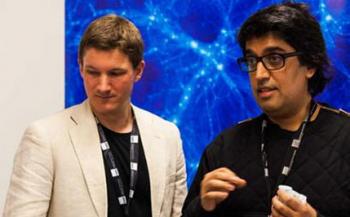 Benedikt Diemer (Ph.D candidate, Astronomy & Astrophysics, UChicago); Isaac Facio (MFA candidate, Fiber & Material Studies, SAIC) Faculty Advisors: Andrey Kravtsov (Astronomy & Astrophysics, UChicago); Helen Maria Nugent (Designed Objects (AIADO), SAIC) The Fabric of the Universe is an investigation into a novel way of visualizing the structure of the universe: using 3-dimensional textiles. Isaac Facio and Benedikt Diemer will transform the shapes formed by the dark matter in large computer simulations into fabric using digital textile manufacturing technologies. The properties of the fabric, such as its opacity, will represent the properties of dark matter structures, such as their density. Ultimately, the textile will take shape in a large-scale sculpture of the dark matter filaments and nodes in the universe, known as the "cosmic web". Funded by the Graduate Division, School of the Art Institute of Chicago (SAIC). Read more >> Related Links: KICP Members: Andrey V. Kravtsov KICP Students: Benedikt Diemer Cosmic convergence AAAS, Science, August 3, 2015 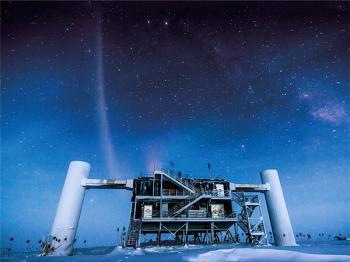 PHOTO: FELIPE PEDREROS, ICECUBE/NSF A year and half ago, physicists working with one of the world's odder scientific instruments scored a bittersweet breakthrough. The massive IceCube particle detector - a 3D array of 5160 light sensors buried kilometers deep in ice at the South Pole - spotted ghostly subatomic particles called neutrinos from beyond our galaxy (Science, 22 November 2013, p. 920). Researchers had previously detected lower energy neutrinos gushing from the sun and raining down from particle interactions in the atmosphere. But - except for a burp from a nearby supernova explosion in 1987 - neutrinos from the far reaches of the cosmos had eluded capture. The discovery is Nobel-caliber stuff, some physicists say, but it also sounded a cautionary note. IceCube saw only about a dozen cosmic neutrinos per year. At that meager rate, the $279 million detector might never spot enough of them to work as advertised: as a neutrino telescope that could open up a whole new view of the heavens. But as the data continue to come in, researchers are optimistic. After all, the fact that cosmic neutrinos have been spotted means that a big enough detector should be able to harvest enough of them to study the sky, says Francis Halzen, a theoretical physicist at the University of Wisconsin, Madison, and the driving force behind IceCube. "We see the flux, and now we have to figure out what it takes to do astronomy with it," he says. Halzen and his team are pushing to expand IceCube, which already fills a volume of a cubic kilometer. Meanwhile, other researchers have developed approaches that they say could be cheaper and more efficient. More important, cosmic neutrinos are already telling a story, especially when combined with other particles from space: highly energetic photons called gamma rays, and ultrahigh-energy cosmic rays - protons and heavier atomic nuclei that reach energies a million times higher than humans have achieved with particle accelerators. Physicists have long wondered where in the universe the most energetic neutrinos, gamma rays, and cosmic rays are born. Now, in a tantalizing convergence, all three questions appear to share the same answer, says Olga Botner, a physicist and IceCube team member from Uppsala University in Sweden. "We believe that the engines that generate the cosmic rays also generate the gamma rays and neutrinos," she says. If so, physicists have only one mystery to solve. The convergence also suggests the solution won't require exotic new particle physics: The conventional astrophysics of stars and galaxies should suffice. AS TRACERS of the heavens, neutrinos offer many advantages over other particles from space. Electrically charged cosmic rays swirl in galactic magnetic fields; gamma rays tangle with radiation lingering from the big bang - the cosmic microwave background (CMB). Uncharged neutrinos, by contrast, zoom straight from their sources through almost everything the universe throws at them. "Neutrinos are the ultimate high-energy messenger," says Abigail Vieregg, a physicist at the University of Chicago in Illinois. "They're perfect - if you can see them." Read more >> Related Links: KICP Members: Abigail G. Vieregg Three New Kavlis and Brain Initiative: The Kavli Foundation and University Partners Commit $100 Million to Brain Research The Kavli Foundation, October 7, 2015 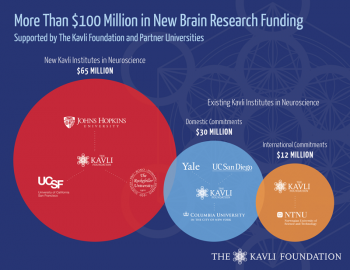 WASHINGTON, D.C. - Thursday, October 1 - The Kavli Foundation and its university partners announced today the commitment of more than $100 million in new funds to enable research aimed at deepening our understanding of the brain and brain-related disorders, such as traumatic brain injuries (TBI), Alzheimer's disease and Parkinson's disease. On October 1, 2015 a bipartisan briefing was held on Capitol Hill regarding a new commitment to support brain research and an update on the BRAIN Initiative. Including details about new funding and research endeavors and a discussion that will focus on the BRAIN Initiative and on the future of neuroscience. Joining the discussion will be leaders from the White House Office of Science and Technology Policy, the National Institutes of Health, and the National Science Foundation. "We are delighted to announce this major commitment to promoting a sustained interdisciplinary effort to solve the mysteries of the brain," said Rockell N. Hankin, Chairman of the Board of Directors at The Kavli Foundation. "By transcending the traditional boundaries of research, the new neuroscience institutes will make breakthrough discoveries possible." The majority of the funds will establish three new Kavli neuroscience institutes at the Johns Hopkins University (JHU), The Rockefeller University and the University of California, San Francisco (UCSF). These institutes will become part of an international network of seven Kavli Institutes carrying out fundamental research in neuroscience, and a broader network of 20 Kavli Institutes dedicated to astrophysics, nanoscience, neuroscience and theoretical physics. The new funding will support research that moves forward the national Brain Research through Advancing Innovative Neurotechnologies (BRAIN) Initiative, a public and private collaboration launched by President Obama in April 2013. At the time of the President's announcement, The Kavli Foundation publicly pledged to spend $40 million in support of basic neuroscience research. "With this announcement, the Foundation more than meets this commitment," said Robert W. Conn, President and CEO of The Kavli Foundation. "The establishment of three new institutes, along with the added investment in our existing neuroscience institutes, will further empower great scientists to help write the next chapter in neuroscience." The BRAIN Initiative is supported by federal agencies, including the National Institutes of Health, National Science Foundation, and the Defense Advanced Research Projects Agency, and private partners such as The Kavli Foundation. "The President launched the BRAIN Initiative to help unlock the mysteries of the brain, to improve our treatment of conditions like Alzheimer's and autism, and to deepen our understanding of how we think, learn, and remember. The Kavli Foundation is responding to the President's call to action by making investments to advance the goals of the BRAIN Initiative. I hope this spurs other private, philanthropic, and academic institutions to support this important initiative," said John P. Holdren, PhD, assistant to the President for Science and Technology, and director of the White House Office of Science and Technology Policy. The three new institutes are the Kavli Neuroscience Discovery Institute at JHU, the Kavli Neural Systems Institute at The Rockefeller University and the Kavli Institute for Fundamental Neuroscience at UCSF. Each of the Institutes will receive a $20 million endowment supported equally by their universities and the Foundation, along with start-up funding. The Foundation is also partnering with four other universities to build their Kavli Institute endowments further. These Institutes are at Columbia University, the University of California, San Diego, Yale University and the Norwegian University of Science and Technology. The BRAIN Initiative calls specifically for establishing new interdisciplinary collaborations aimed at creating novel new technologies for visualizing the brain at work. "The cultivation of diverse partnerships, with government, big and small business, non-profits and academia, is a critical step on the path to unravel the mysteries of the brain," National Science Foundation Director France Cordova, PhD, said. "Only through continued investments in collaborative, fundamental research will we develop the innovative tools and technologies needed to help us understand the brain, which is the ultimate goal of the BRAIN Initiative. Progress in this area will bolster America's health, economy and security." In the spirit of the interdisciplinary charge of the BRAIN Initiative, the new Kavli Institutes each work across their universities and with outside partners: - The mission of the new Kavli Neuroscience Discovery Institute (Kavli NDI) at JHU is to bring together neuroscientists, engineers and data scientists to investigate neural development, neuronal plasticity, perception and cognition. "The challenges of tomorrow will not be confined to distinct disciplines, and neither will be the solutions we create," said Johns Hopkins University President Ronald J. Daniels. "The Kavli Foundation award is a tremendous honor, because it allows Johns Hopkins to build on our history of pioneering neuroscience and catalyze new partnerships with engineers and data scienctists that will be essential to building a unified understanding of brain function." - At The Rockefeller University, the Kavli Neural Systems Institute (Kavli NSI) will also promote interdisciplinary research and learning to tackle the biggest questions in neuroscience through high-risk, high-reward projects and the development of new research technologies. "Kavli's investment in neuroscience at Rockefeller will enable us to create and share new research approaches and laboratory technologies to capture the possibilities of neuroscience from the micro to the macro level," said Rockefeller President Marc Tessier-Lavigne, PhD. "For example, Rockefeller scientists are currently developing a number of tools to push neuroscience forward, including advanced neuronal recording capabilities, sophisticated three-dimensional imaging, and non-invasive activation of neural circuits, among others." - The Kavli Institute for Fundamental Neuroscience (Kavli IFN) at UCSF will focus initially on understanding brain plasticity, the remarkable capacity of the brain to modify its structure and function. The Kavli IFN will partner with engineers at two San Francisco Bay-area national laboratories to develop new tools and approaches to brain research. "UCSF scientists have made some of the seminal discoveries in modern neuroscience," said UCSF Chancellor Sam Hawgood, MBBS. "The Kavli Institute will sustain this rich tradition into the 21st Century." "While private funding should never supplant federal funding," said Conn, "the scientific enterprise also depends on philanthropic giving to catalyze pioneering new directions and discoveries." "Understanding the complex language of brain circuits - and how they function in both health and disease - is one of the greatest challenges in science. This effort will be made possible by cooperation across disciplines to build the advanced tools necessary to probe the brain in fine detail. The commitment of both public and private organizations brings much needed firepower and interdisciplinary expertise to this endeavor," said Walter Koroshetz, MD, director of the National Institute of Neurological Disorders and Stroke and the co-chair of the NIH BRAIN Initiative. Read more >> Turner on Physics Nobel: Research Showing Neutrinos Have Mass Awarded Nobel Prize Here and Now, October 8, 2015 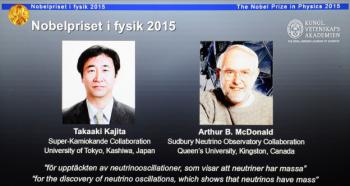 October 6, 2015 at the Swedish Academy of Sciences in Stockholm, Sweden. Takaaki Kajita of Japan and Canada's Arthur B. McDonald won the Nobel Physics Prize for work on neutrinos. (Jonathan Nackstrand/AFP/Getty Images) Looks like John Updike's poem about neutrinos being mass-less objects, "Cosmic Gall," might need an update. Takaaki Kajita of Japan and Arthur McDonald of Canada have been awarded the Nobel Prize in Physics for their discovery that the subatomic particles called neutrinos do have mass. Scientists have called this a historic and major discovery. Michael Turner, director of the Kavli Institute for Cosmological Physics at the University of Chicago, tells Here & Now's Jeremy Hobson how this discovery has changed scientists' understanding of the universe. "The universe has so many neutrinos that they contribute as much to the mass budget of the universe as do the stars we see in the sky," Turner said. He says the neutrino, which he affectionately calls a "lightweight," may be able to tell us about the origins of matter. "The atoms that you and I are made out of, we believe that neutrinos in the early universe had a role in creating the ordinary matter that we're made out of," Turner said. Correction: After our interview aired, Professor Turner sent us this correction: "It is now four Nobels for the neutrino: 1988 for the discovery of the muon neutrino; 1995 for the discovery of the neutrino itself; 2002 for solar and supernova neutrinos; and 2015 for neutrino mass. What a particle!" Guest: Michael Turner, director of the Kavli Institute for Cosmological Physics at the University of Chicago. Read more >> Related Links: KICP Members: Michael S. Turner A Japanese physicist and a Canadian physicist helped to show subatomic 'neutrinos' have mass Inside Science, October 8, 2015 by Ben P. Stein, Inside Science The 2015 Nobel Prize in physics has been awarded to a Japanese physicist and a Canadian physicist for discovering that abundant subatomic particles known as neutrinos can undergo changes in their identity, a process that requires the particles, once thought to be massless, to possess mass. The prize goes jointly to Takaaki Kajita of the University of Tokyo in Japan and Arthur B. McDonald of Queen's University in Kingston, Canada "for the discovery of neutrino oscillations, which shows that neutrinos have mass." The two recipients were leaders of two major underground neutrino observatories on opposite sides of the world. Kajita was part of the Super-Kamiokande collaboration in Japan, and McDonald led a group at the Sudbury Neutrino Observatory, or SNO, in Canada. "Neutrinos are a puzzle and this year's Nobel Prize in physics honors a fundamental step toward unveiling the nature of the neutrino," said Olga Botner, a member of the Nobel Committee for Physics and a professor of physics at Uppsala University in Sweden. "This is a great prize," said physicist Michael Turner, director of the Kavli Institute for Cosmological Physics at the University of Chicago. He added that this is the latest of four neutrino-related Nobel Prizes, from 1988 to 2015. Today's announcement was "doubly wonderful," said Gene Beier, a professor of physics at the University of Pennsylvania who was a U.S. co-spokesperson for the SNO experiment. Beier had also worked in the Kamiokande II experiment, a predecessor to Super-Kamiokande. Both experiments provided big answers. "Neutrinos are among the fundamental particles," explained McDonald by phone during this morning's Nobel announcement in Sweden. "The neutrino has a mass and it's more than a million times lighter than the electron," said Botner. "Neutrinos punch above their weight. They contribute as much mass as stars do," Turner said. The prize goes jointly to Takaaki Kajita of the University of Tokyo in Japan and Arthur B. McDonald of Queen's University in Kingston, Canada "for the discovery of neutrino oscillations, which shows that neutrinos have mass." The two recipients were leaders of two major underground neutrino observatories on opposite sides of the world. Kajita was part of the Super-Kamiokande collaboration in Japan, and McDonald led a group at the Sudbury Neutrino Observatory, or SNO, in Canada. Read more >> Related Links: KICP Members: Michael S. Turner Eckhardt Research Center to begin new phase of ambitious science The University of Chicago News Office, October 29, 2015 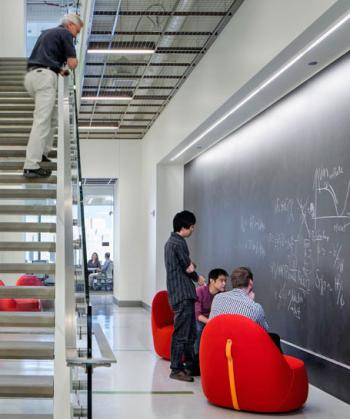 The appetite for discovery at the new William Eckhardt Research Center was articulated by the University of Chicago’s very first Nobel laureate, astrophysicist Albert A. Michelson. "If a poet could at the same time be a physicist, he might convey to others the pleasure, the satisfaction, almost the reverence, which the subject inspires," Michelson wrote in his 1903 book Light Waves and Their Uses. The Eckhardt Research Center enables precision science of many kinds, encompassing engineering in the quantum realm as well as studies of distant planets and cosmic evolution. In this sense too it carries on the spirit of Michelson, whose studies of light influenced microscopy as well as astronomy. On Oct. 29 the UChicago community is celebrating the dedication of the Eckhardt Research Center, named for Chicago futures trader and alumnus William Eckhardt, SM'70, in recognition of his generous philanthropy to the sciences at the University of Chicago. The center is home to the Institute for Molecular Engineering and several sections of the Physical Sciences Division, including the Department of Astronomy and Astrophysics and the Kavli Institute for Cosmological Physics. "We are excited that the William Eckhardt Research Center provides a sophisticated and beautiful home to support our distinctive programs in molecular engineering and astrophysics," said Provost Eric Isaacs. "IME has been successful in building a new model for molecular-level research with broad impact, and this facility will allow for even more ambitious work. Equally significant, this building befits the Department of Astronomy and Astrophysics long tradition of scientific eminence, and its continuing importance in that field of study." The construction project was a collaboration of HOK, an architecture firm that specializes in the design of science and technology buildings, and Jamie Carpenter, an artist, sculptor, and architect known for his innovative work with light and glass. The structure will be equipped with high-performance laboratories that will allow researchers to translate quantum information science into new technologies, develop instruments that can detect planets orbiting distant stars, and much more. "We will find Earth-like planets and maybe signs of life from these planets," says Angela Olinto, the Homer J. Livingston Professor and chair of Astronomy and Astrophysics. "We will explore the most extreme events of the universe and try to explain what causes these events. We will study the first stars in the first galaxies ever assembled in the universe. We will also probe the most fundamental forces of the universe in the first tiny fraction of a second after the Big Bang." Sharing the Eckhardt Center holds particular potential for new collaborations and interactions among scholars in the Institute for Molecular Engineering and the Physical Sciences. "We will really span activities from the tiniest to the most gigantic," said Dean Matthew Tirrell, the founding Pritzker Director of IME and Argonne National Laboratory's deputy director for science. "Molecular engineering can contribute to astronomy and astrophysics via fabrication of new detectors and other instrumentation." Fostering partnerships and interactions One of the unique aspects of the Eckhardt Research Center is the Pritzker Nanofabrication Facility. Located in the first basement of the center, the innovative facility will allow for fabricating new features and devices at the nanoscale level, supporting IME's goal to solve societal issues with molecular-sized tools and solutions. The nanofabrication lab "provides a unique research and development environment for the academic and industrial scientist interested in pursuing state-of-the-art micro- and nanoscale fabrication," says Andrew Cleland, the John A. MacLean Sr. Professor for Molecular Engineering Innovation and Enterprise, who will lead the facility. "We anticipate drawing researchers from the Chicago area, the Midwest, and nationally, both to use this facility and to establish collaborations with IME and UChicago researchers." The breadth of scholarship at the Eckhardt Research Center is a good match for the Kavli Institute, which explores the profound connections between physics at the smallest and largest of scales - from quarks to the cosmos - with a focus on dark matter, dark energy, and how the universe began. The Kavli Institute will collaborate with IME researchers to create detectors for instruments that will make the most precise measurements of the cosmic microwave background - the microwave echo of the Big Bang. "To recruit top faculty and top students requires the facilities to allow them to do the best science they can do," says Rocky Kolb, dean of the Physical Sciences Division and the Arthur Holly Compton Distinguished Service Professor of Astronomy and Astrophysics. "With the Eckhardt Research Center, we will have the facilities and the infrastructure that will allow our faculty and students to explore the cosmos - in ways they have never been able to before." Exploring new fields and pushing boundaries The center will create the first dedicated home for IME since it was created in 2011 in partnership with Argonne. Having all IME researchers in the same location, with diverse backgrounds ranging from chemical engineering to engineering physics to biomedical engineering, will be beneficial for future partnerships within IME itself, Tirrell said. The idea of pushing research frontiers that cross disciplinary boundaries has permeated the Department of Astronomy and Astrophysics, the Kavli Institute, and the Institute of Molecular Engineering for years. "We have, in astronomy, a reputation of being an innovative department that does new things," says Kolb. "We were the first department to do astrophysics. Particle cosmology really was developed here. It's part of our nature to explore new fields and transcend boundaries." - Story includes material that first appeared on the Institute for Molecular Engineering website. Read more >> Related Links: KICP Members: Edward W. Kolb; Angela V. Olinto; Michael S. Turner New ultra-sensitive instrument aims to detect hints of elusive dark matter particles The University of Chicago News Office, November 11, 2015 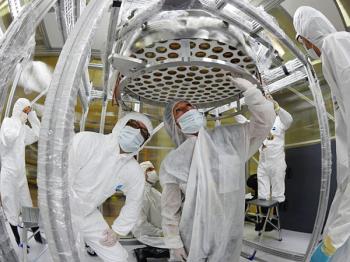 There is five times more dark matter in the universe than "normal" matter - the atoms and molecules that make up the familiar world. Yet, it is still unknown what this dominant dark component actually is. On Nov. 11 an international collaboration of scientists inaugurated the new XENON1T instrument designed to search for dark matter with unprecedented sensitivity at the Gran Sasso Underground Laboratory in Italy. Dark matter is one of the basic ingredients of the universe, and searches to detect it in laboratory-based experiments have been conducted for decades. However, until today dark matter has been observed only indirectly, via its gravitational interactions that govern the dynamics of the cosmos at all length-scales. It is expected that dark matter is made of a new, stable elementary particle that has escaped detection so far. "We expect that several tens of thousands of dark matter particles per second are passing through the area of a thumbnail," said Luca Grandi, a UChicago assistant professor in physics and a member of the Kavli Institute for Cosmological Physics. "The fact that we did not detect them yet tells us that their probability to interact with the atoms of our detector is very small, and that we need more sensitive instruments to find the rare signature of this particle." Grandi is a member of the XENON Collaboration, which consists of 21 research groups from the United States, Germany, Italy, Switzerland, Portugal, France, the Netherlands, Israel, Sweden and the United Arab Emirates. The collaboration's inauguration event took place Nov. 11 at the Laboratori Nazionali del Gran Sasso, one of the largest underground laboratories in the world. "We need to put our experiment deep underground, using about 1,400 meters of solid rock to shield it from cosmic rays," said Grandi, who participated in the inauguration along with guests from funding agencies as well as journalists and colleagues. About 80 visitors joined the ceremony at the laboratory's experimental site, which measures 110 meters long, 15 meters wide and 15 meters high. There, the new instrument is installed inside a 10-meter-diameter water shield to protect it from radioactive background radiation that originates from the environment. During introductory presentations, Elena Aprile, Columbia University professor and founder of the XENON project, illustrated the evolution of the program. It began with a 3 kilogram detector 15 years ago. The present-day instrument has a total mass of 3,500 kilograms. Fighting against radioactivity XENON1T employs the ultra-pure noble gas xenon as dark matter detection material, cooled down to -95 degrees Celsius to make it liquid. "In order to see the rare interactions of a dark matter particle in your detector, you need to build an instrument with a large mass and an extremely low radioactive background," said Grandi. "Otherwise you will have no chance to find the right events within the background signals." For this reason, the XENON scientists have carefully selected all materials used in the construction of the detector, ensuring that their intrinsic contamination with radioactive isotopes meet the low-background experiment’s requirement. "One has to realize that objects without any radioactivity do not exist," Grandi explained. "Minute traces of impurities are present in everything, from simple things like metal slabs to the walls of the laboratory to the human body. We are trying to reduce and control these radioactive contaminants as much as possible." The XENON scientists measure tiny flashes of light and charge to reconstruct the position of the particle interaction within their detector, as well as the deposited energy and whether it might be induced by a dark matter particle or not. The light is observed by 248 sensitive photosensors, capable of detecting even single photons. A vacuum-insulated double-wall cryostat, resembling a gigantic version of a thermos flask, contains the cryogenic xenon and the dark matter detector. The xenon gas is cooled and purified from impurities in the three-story XENON building, an installation with a transparent glass facade next to the water shield, which allows visitors to view the scientists inside. A gigantic stainless-steel sphere equipped with pipes and valves is installed on the ground floor. "It can accommodate 7.6 tons of xenon in liquid and gaseous form," said Aprile. "This is more than two times the capacity we need for XENON1T, as we want to be prepared to swiftly increase the sensitivity of the experiment with a larger mass detector in the near future." Aiming for a dark matter detection Once fully operational, XENON1T will be the most sensitive dark matter experiment in the world. Grandi's group has been deeply involved in the preparation and assembly of the xenon Time Projection Chamber, the core of the detector. His group is also in charge for the development of the U.S. computing center for XENON1T data analysis via the UChicago Research Computing Center, directed by Birali Runesha, in close cooperation with Robert Gardner and his team at the Computation Institute. In addition to Columbia's Aprile, leading the other six U.S. institutions are Ethan Brown, Rensselaer Polytechnic Institute; Petr Chaguine, Rice University; Rafael Lang, Purdue University; Kaixuan Ni, University of California, San Diego; and Hanguo Wang, University of California, Los Angeles. XEON1T's first results are expected in early 2016. The collaboration expects the instrument to achieve most of its objectives within two years of data collection. The researchers then will move their project into a new phase. "Of course we want to detect the dark matter particle," Grandi said, "but even if we have only found some hints after two years, we are in an excellent position to move on as we are already now preparing the next step of the project, which will be the far more sensitive XENONnT." Read more >> Related Links: KICP Members: Luca Grandi Scientific projects: XENON1T Pierre Auger Observatory celebrates 15 years of achievements and a new International Agreement with a Symposium Pierre Auger Observatory, December 10, 2015 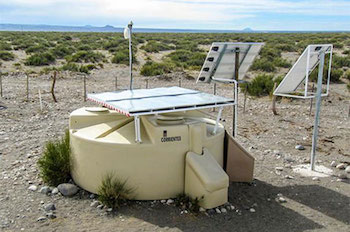 AugerPrime Symposium Celebrating 15 years of achievements and signature ceremony of a new International Agreement for the next 10 years The Pierre Auger Observatory is the world's leading science project for the exploration of cosmic rays. More than 500 scientists from 16 countries have been working together since 1998 in the Province of Mendoza, Argentina, to elucidate the origin and properties of the most energetic particles in the Universe, coming to us from the far reaches of the cosmos. The Pierre Auger Observatory measures gigantic showers of relativistic particles that are the result of collisions between the very rare, highest-energy cosmic rays and atomic nuclei of the atmosphere. Properties of such air showers are used to infer the energy, direction, and mass of the cosmic particles. Results from the Pierre Auger Observatory have brought new fundamental insights into the origin and nature of highest-energy cosmic rays. One of the most exciting results is the experimental proof that at the highest energies (7 orders of magnitude above that of the proton beams circulating in the CERN's Large Hadron Collider) the cosmic-ray flux decreases much faster than at low energies. Data indicate that, in addition to the propagation effect known as GZK cutoff, this flux suppression may reveal the limiting energy of the most powerful cosmic particle accelerators. An even more detailed measurement of the nature of cosmic particles at the highest energies is crucial to understand the mechanisms responsible for this decrease, and to identify the astrophysical sites violent enough to accelerate particles to such tremendous energies. The AugerPrime upgrade to the Observatory enhances the 1660 existing surface detectors (water tanks sensitive to Cherenkov light generated by the shower products) with new scintillation detectors, so that electromagnetic and muonic shower particles can be separated more efficiently. This in turn, together with smaller area of buried muon detectors, improves the determination of the mass of the primary cosmic rays, otherwise not directly measurable. Faster and more powerful electronics also facilitates the readout of the new detector components and enhances the overall performance of the Observatory elements. A symposium, held on November 15-16, 2015 gathers collaborators and science funding agency representatives for the signing of a new international agreement for continued operation of the Pierre Auger Observatory until 2025. This will provide the basis for doubling the present statistics with the upgraded Observatory, and for solving the long-standing puzzle of the origin of the most energetic particles in the Universe. Read more >> Related Links: KICP Members: James W. Cronin; Angela V. Olinto; Paolo Privitera Controversial experiment sees no evidence that the universe is a hologram Science Magazine, December 10, 2015 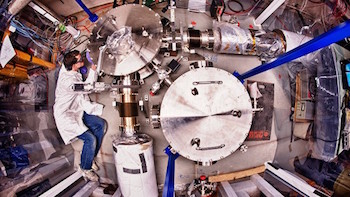 It's a classic underdog story: Working in a disused tunnel with a couple of lasers and a few mirrors, a plucky band of physicists dreamed up a way to test one of the wildest ideas in theoretical physics—a notion from the nearly inscrutable realm of "string theory" that our universe may be like an enormous hologram. However, science doesn't indulge sentimental favorites. After years of probing the fabric of spacetime for a signal of the "holographic principle," researchers at Fermi National Accelerator Laboratory (Fermilab) in Batavia, Illinois, have come up empty, as they will report tomorrow at the lab. The null result won't surprise many people, as some of the inventors of the principle had complained that the experiment, the $2.5 million Fermilab Holometer, couldn't test it. But Yanbei Chen, a theorist at the California Institute of Technology in Pasadena, says the experiment and its inventor, Fermilab theorist Craig Hogan, deserve some credit for trying. "At least he's making some effort to make an experimental test," Chen says. "I think we should do more of this, and if the string theorists complain that this is not testing what they're doing, well, they can come up with their own tests." The holographic principle springs from the theoretical study of black holes, spherical regions where gravity is so intense that not even light can escape. Theorists realized that a black hole has an amount of disorder, or entropy, that is proportional to its surface area. As entropy is related to information content, some theorists suggested that an information-area connection might be extended to any properly defined volume of space and time, or spacetime. Thus, crudely speaking, the maximum amount of information contained in a 3D region of space would be proportional its 2D surface area. The universe would then work a bit like a hologram, in which a 2D pattern captures a 3D image. If true, the principle might guide string theorists in their grand quest to meld the theories of gravity and quantum mechanics. And it would imply, rather astonishingly, that the total amount of information in the observable universe is finite. In 2009 Hogan dreamed up a way to test the idea. One way the holographic principle might come about, he reasoned, is if coordinates in different directions—up-down, forward-backward, right-left—obey a quantum mechanical uncertainty relationship a bit like the famous Heisenberg uncertainty principle, which states that you cannot simultaneously know both the position and momentum of a particle such as an electron. If so, then it should be impossible to precisely define a 3D position, at least on very small scales of 10-35 meters. Hogan figured he could spot the effect using L-shaped optical devices known as interferometers, in which laser light is used to measure the relative length of a device's two arms to within a fraction of an atom's width. If it were impossible to exactly define position, then "holographic noise" should cause the output of an interferometer to jiggle at a frequency of millions of cycles per second, he argued. If two interferometers were placed back to back, they would sample distinct volumes of spacetime, and their holographic noise would be uncorrelated. But if they were nestled one inside the other, the interferometers would probe the same volume of spacetime and the holographic noise would be correlated. And if the interferometers were big enough, that correlated holographic noise should be effectively amplified to observable scales. Now, Hogan, Fermilab experimenter Aaron Chou, and colleagues have done the measurement with interferometers with 39-meter-long arms. Unfortunately for them, they find no evidence of holographic noise. "A correlation that you would attribute to novel physics effects is not seen," says Lee McCuller, a graduate student at the University of Chicago in Illinois, who will present the result in a talk at the lab. Just what the null result means remains unclear, however. Chen says he has never fully understood neither exactly how the experiment works nor Hogan's theory of how the holographic principle originates. What's really needed is some sort of general analysis of what types of theories the experiment can and cannot test, he says. For his part, Hogan says that the experiment reached the sensitivity it aimed for, showing that the technique has the potential to make further measurements. "For me, the big news is that we have a technique for measuring spacetime at this level," he says. In fact, he says, the holometer can be reconfigured to look not for an inherent uncertainty in positions, but rather for a jitter in angular orientation in spacetime—in his view another possible sign of holographic noise. Maybe the underdogs still have a chance, after all. Read more >> Related Links: KICP Members: Craig Hogan; Stephan S. Meyer KICP Students: Lee McCuller Cosmic Showers - Professor Angela Olinto discusses relics from the early Universe showering down at the speed of light. http://llx.fr/site/, December 10, 2015  An astrophysicist and professor in the Department of Astronomy and Astrophysics at the University of Chicago, Angela V. Olinto works in particular on the strongest cosmic rays. From balloon to balloon, with a little help from laser beams, she has endeavored to simulate what could be seen by the JEM telescope to be installed on the EUSO observatory on the International Space Station, looking down towards the Earth: ultra-high energy cosmic rays revealing themselves through fluorescent showers of particles, possible messengers from the very first moments of the Universe after the Big Bang. Read more >> Related Links: KICP Members: Angela V. Olinto NASA's Fermi Satellite Kicks Off a Blazar-detecting Bonanza NASA, December 15, 2015 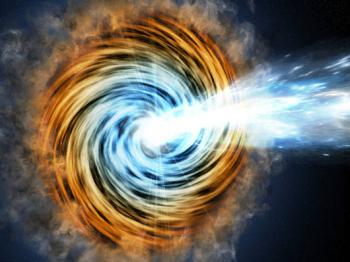 Credits: M. Weiss/CfA A long time ago in a galaxy half the universe away, a flood of high-energy gamma rays began its journey to Earth. When they arrived in April, NASA's Fermi Gamma-ray Space Telescope caught the outburst, which helped two ground-based gamma-ray observatories detect some of the highest-energy light ever seen from a galaxy so distant. The observations provide a surprising look into the environment near a supermassive black hole at the galaxy's center and offer a glimpse into the state of the cosmos 7 billion years ago. "When we looked at all the data from this event, from gamma rays to radio, we realized the measurements told us something we didn't expect about how the black hole produced this energy," said Jonathan Biteau at the Nuclear Physics Institute of Orsay, France. He led the study of results from the Very Energetic Radiation Imaging Telescope Array System (VERITAS), a gamma-ray telescope in Arizona. Astronomers had assumed that light at different energies came from regions at different distances from the black hole. Gamma rays, the highest-energy form of light, were thought to be produced closest to the black hole. "Instead, the multiwavelength picture suggests that light at all wavelengths came from a single region located far away from the power source," Biteau explained. The observations place the area roughly five light-years from the black hole, which is greater than the distance between our sun and the nearest star. The gamma rays came from a galaxy known as PKS 1441+25, a type of active galaxy called a blazar. Located toward the constellation Boötes, the galaxy is so far away its light takes 7.6 billion years to reach us. At its heart lies a monster black hole with a mass estimated at 70 million times the sun's and a surrounding disk of hot gas and dust. If placed at the center of our solar system, the black hole's event horizon -- the point beyond which nothing can escape -- would extend almost to the orbit of Mars. As material in the disk falls toward the black hole, some of it forms dual particle jets that blast out of the disk in opposite directions at nearly the speed of light. Blazars are so bright in gamma rays because one jet points almost directly toward us, giving astronomers a view straight into the black hole's dynamic and poorly understood realm. Read more >> Related Links: Scientific projects: Fermi Gamma-ray Space Telescope (Fermi); Very Energetic Radiation Imaging Telescope Array System (VERITAS) |





 Overview
Overview